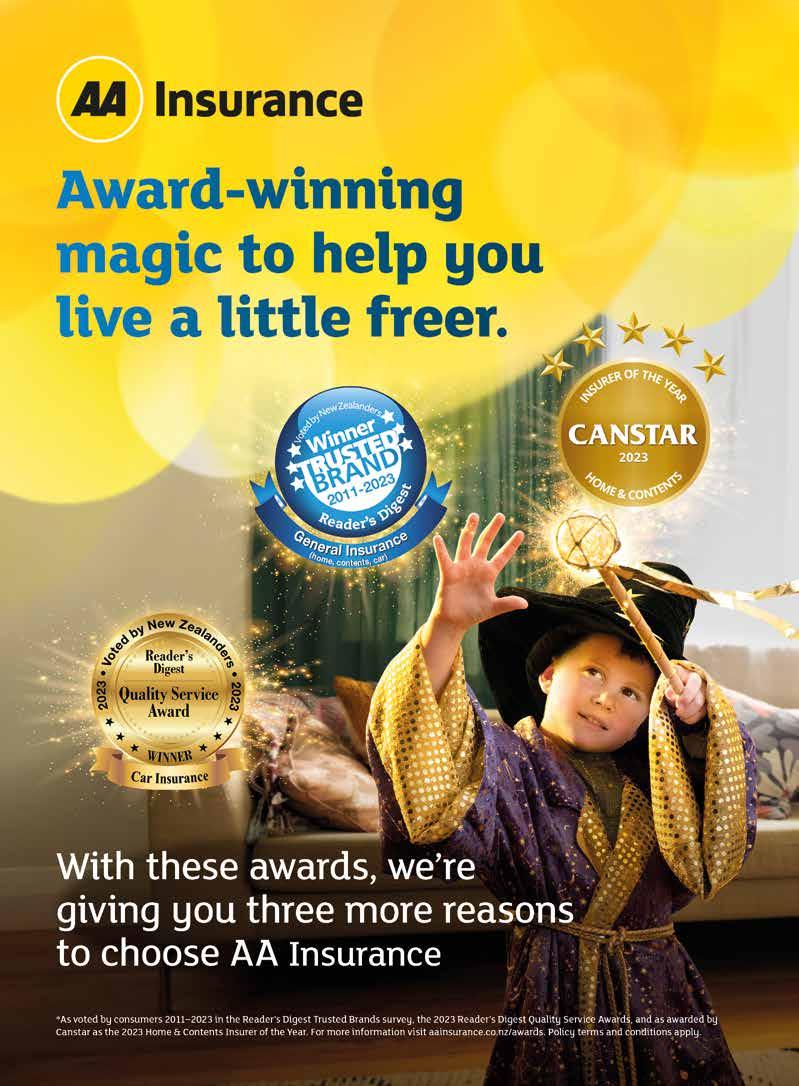
READER PRIZE
Win an e-bike!
NEW ZEALAND TRAVEL
By road and rail
CONGESTION CHARGING
What are the pros and cons?





READER PRIZE
Win an e-bike!
NEW ZEALAND TRAVEL
By road and rail
CONGESTION CHARGING
What are the pros and cons?



When it comes to health check-ups, sometimes our eyes can come in last on the list of priorities – especially if we feel there’s nothing particularly wrong with them.
However, according to Specsavers Optometrist David Aldridge, regular eye tests could be the key to maintaining long-term overall health.
“An eye test is more than just a simple vision check,” he explains. “It’s also a comprehensive examination of your eye health. As optometrists, we can pick up on indications of other broader health concerns from an eye test. So, to make sure potential issues are picked up early, it’s really important to get your eyes tested regularly.”
But how often should we book an eye test to make sure any issues are caught early? That depends, David says.
“The professional recommendation for having an eye test is every two years but sometimes we might recommend you come back more often for a variety of different reasons,” he says. “For example, monitoring cataracts or a problem in the back of the eye. Sometimes there’s been a change in the patient’s prescription that we need to monitor, or there could be some medical issues present, like diabetes, that are predisposed to particular eye problems. It’s always better to catch potential health concerns, of any kind, as early as possible.”
From the age of 40 onwards, the majority of Kiwis will start to notice their reading vision starting to become strained or blurred, he says. These symptoms can be an indicator of a range of different problems and it’s best they’re monitored and assessed by an expert.
At Specsavers, all of our stores have hospital-grade technology to help detect sight-threatening eye conditions through an advanced 3D scan of the back of the eye. Tests at least every two years –or more frequently if advised –are essential for early detection of eye health issues.
“The good news is, AA Members can access a free eye test every two years” concludes David.


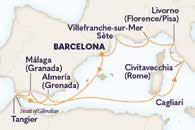
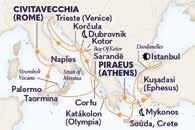


9-DAY ADRIATIC & ITALIAN SPLENDORS

Trieste (Venice) to Civitavecchia (Rome)
Oosterdam
5 Jul 2024*
*Ship and map based on 05/07/24 cruise.
18-DAY MALTA & MEDITERRANEAN ROMANCE
Civitavecchia (Rome) to Barcelona
Oosterdam
1 Sep 2024*
Ship and map based on 01/09/24 cruise.

11-DAY WESTERN MEDITERRANEAN MEDLEY
Barcelona roundtrip (Rome)
Oosterdam
3 May 2024*
Ship and map based on 03/05/24 cruise.

21-DAY ATHENS, ADRIATIC & ITALY: MYKONOS & PALERMO

Piraeus (Athens) to Civitavecchia
Oosterdam
8 Jun 2024*
Ship and map based on 08/06/24 cruise.
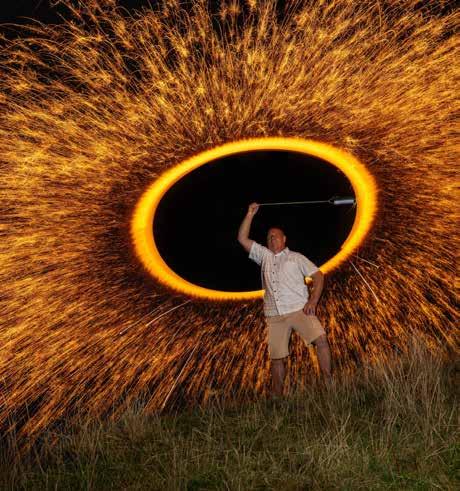
“You do what for a living?” We speak to eight Kiwis who have carved out careers in unique, unusual and unexpected arenas, from whistling at kiwi eggs, to driving stunt cars, to crafting some of New Zealand’s most impressive fireworks displays.
New Zealand’s Poet Laureate, Chris Tse, shares his creative process and vision for the future of poetry in Aotearoa. Plus, we highlight upcoming events across the country and share the chance to win prizes including an e-bike valued at over $5k.
A journey from Wellington to Golden Bay crosses the Cook Strait and uncovers some of the most scenic spots at the top of the South Island.

Island time
Golden sands, fresh coconuts and the chance to see majestic humpback whales in the wild: the Kingdom of Tonga offers a truly tropical escape.
69
Renovation station
We visit a reimagined family home in Wellington with a decidedly fishy past.
Build to rent
Can we build our way out of the housing crisis? A new approach from the team at Simplicity.

Congestion charging: the potential extra price of travel in our cities.

We chat to legendary Formula 1 coach, Rob Wilson, about working with today’s driving stars.

Pet owners with AA Pet Insurance are eligible for complimentary consults with VetChat’s 24/7 online helpdesk.
Young gun
We meet Kritika Selach, one of the AA’s youngest councillors, representing young people’s views on road safety and public transport.


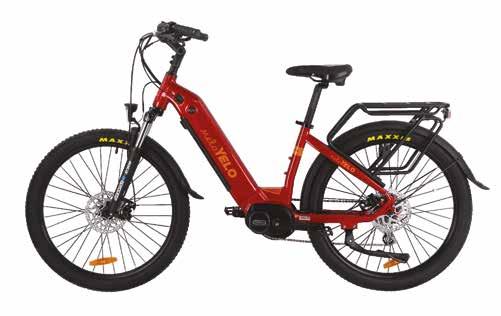



Government late last year resulted in a flurry of changes in transport, including the removal of the Clean Car Discount and the halting of light rail projects in Auckland and Wellington. It also
confirmed the previous Government’s decision to introduce Road User Charges for electric vehicles (EVs), ensuring all road users contribute to the maintenance of our roads. It was also pleasing to see the Government supporting many of the AA’s Election Calls which were compiled in response to Members’ concerns.
You told us you want to see action on road maintenance and a lifting of the standard of regional highways, for the Government to make the roading network more resilient, and an increase of public charging facilities for EVs throughout the nation. We look forward to seeing these commitments come to life this year, and continuing to advocate on behalf of our Members on the issues that matter to you.
I’m thrilled to say that AA Membership continues to grow. A key focus for me and the team is to evolve the Association to ensure we remain relevant and highly valued for generations to come.
To do this we need to keep delivering to you, our Members, with compelling products, services and benefits you love. AA Members bought more than 9,000 discounted EVENT Cinema tickets this January alone, 36% more than January last year. So we know you enjoy your movies! We look forward to introducing more exciting benefits in the future.
We also continue to take steps to support the transition to sustainable mobility. Adoption of lower-carbon ways of moving around, over time, is important to help keep New Zealand’s emissions down. As experts in this space we can also keep you informed of your options.
Lastly, we need to keep the Association strong and resilient by diversifying revenue through innovative new products and services, so we can weather the inevitable economic ups and downs.
From my perspective, the future is looking bright. We’ve got a great team on board and I’m pleased to say that the AA is a hive of activity as we work towards acheiving our goals.
The focus right now is laying a strong foundation which we can build from, starting with modernising our technology and making our systems and processes more efficient. We’re making great progress in this space and while some of the changes might not be visible to you, I hope they show up in the experience you have with us.
Thank you for being a Member of the AA and trusting me and the team as we evolve the Association into its next great era.
Ngā mihi. Thank you.
Nadine Tereora CHIEF EXECUTIVEEDITORIAL TEAM
Kathryn Webster
Emily Draper
Jo Percival
DESIGN AND ART DIRECTION
Julian Pettitt, Senior Designer at SCG
HOW TO REACH US
EDITORIAL
AA Directions
He Ngākau, Level 5, 20 Viaduct Harbour Avenue, Auckland, 1010 99 Albert St, Auckland Central PO Box 5, Auckland, 1140 Ph: 09 966 8800
Email: editor@aa.co.nz
ADVERTISING
Moira Penman 027 563 0421 moira@gsjadvisory.com.au
SUBSCRIPTIONS AND MEMBERSHIP ENQUIRIES:
Ph: 0800 500 444
ISSN 1171-0179
Published in print twice a year Circulation 665,731
Readership AC Nielsen 795,000 PRODUCTION
SCG, Auckland PRINTED
Webstar, Auckland

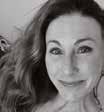
DEBBIE GRIFFITHS
ON THE COVER
Photograph by Jessie Casson Design by Julian Pettitt

NOTE: The views of contributing writers are not necessarily those of AA Directions or the AA. While AA Directions makes every effort to ensure that no misleading claims are made by advertisers, responsibility cannot be accepted by AA Directions or the AA for the failure of any product or service to give satisfaction. Inclusion of a product or service should not be construed as endorsement of it by AA Directions or by the Automobile Association.
Debbie is a multi-media expert, having spent over 20 years as a radio journalist and news reader, four years as a TV presenter, as well as a travel writer for print media. These days, the freelance content creator lives near the beach in Bay of Plenty and can often be found pouring over maps, planning road trips. Debbie wrote two stories for this issue’s feature on unusual jobs; see p.26 and p.32.
Without exception, the people who star in our Dream Jobs feature chose to turn their passion into their career. They all talk about loving what they do. It gives new meaning to 'making a living'. By earning enough to pay the bills doing what they want to be doing anyway, they're making life work for them. Yes, it's fortunate to have the talent and to get the timing right, but it's also about making smart choices, requiring clarity and courage. Read on, for inspiration!
Kathryn Webster EDITOR
One of Emily's first jobs was writing Facebook message replies for Prime Minister Jacinda Ardern. Since then, she has managed to craft a career from the things she loves most: people and words. She has written about everything from travel to psychology, politics and culture and is passionate about new experiences, good conversation, and strong Yorkshire tea. Emily is currently the acting Deputy Editor for AA Directions
In our digital Summer issue of AA Directions, we asked: Have you noticed more aggressive or threatening behaviour from other drivers on the road recently?
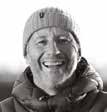
Based in the UK, Matt Howell is a specialist motoring photographer who has travelled the world shooting for the full alphabet of car brands – from Aston Martin to Zagato. Although most of his work is for manufacturers, Matt has also been privileged to shoot many of the most beautiful historic cars ever made. He owns two 1960s VW Beetles and a Morgan 4/4. See Matt’s images of motorsport legend Rob Wilson on p.40.
This issue we ask: Would you take an alternative route to avoid motorway congestion charges? Go to aadirections.co.nz to have your say. YES: 60% NO: 40%

In Nelson, there are many council-approved ways to pollute the region. First you can get on the dirty diesel double decker bus that is maintained as a quaint reminder of yesteryear. In this time of a climate emergency (declared by our council) running this diesel bus is contrary to any sensible strategy, as we have electric buses that can cover the route. The dirty bus carries you to Tahunanui Beach where there is the go-kart racetrack. Of course, these could be electric, but they are polluting, gas-driven fun. Then there are the bumper boats that run highly polluting engines that discharge their exhaust underwater. Finally, there are little polluting trains that pull the kids around. It is absurd to burn fossil fuels for ‘fun’ in the time of a climate crisis. I ask the council to take responsibility in this regard and promote activities that do not cost the Earth.
J. Hobbs
NELSON
I wish to commend those responsible for getting the speed limit dropped on many roads. Recently we drove between Blenheim and Havelock where the speed limit was mostly 80km/h and, with the roads having been widened and many of the curves reduced, it was an easy drive. I’m not sure if the accident rate has decreased on this road or not, but it was such a pleasure just to be able to drive at a safe speed.
B. R. Hetzel
NELSON
Some years ago the roading contractors also had the responsibility for setting out and removing the road signs. This way the signage would only be used when the contractors were actually working. Now that we have a separate contract for traffic management, the timing of the signage does not necessarily match the timing of the road works. The best way to stop poor behaviour is to have motorists and road workers all working together. Put up signs and speed restrictions when there is a genuine
need to do so. Motorists would realise that there is a need to stick to the restrictions and they will respect that. The best way to achieve this change is to put the responsibility for the signage back to the contractors who are doing the work on the roads.
B. Frazer
AMBERLEY
Consider the roadies
I work on the roads for Fulton Hogan. Until I started this job I didn’t realise just how inconsiderate and dangerous some drivers are, speeding through, disregarding and abusing staff. Please consider those whose only wish is to finish a quality job and be on their way.
M. Kennedy
DANNEVIRKE
Slower is better
Regarding the article Changing Speeds (AA Directions, Spring 2023). Besides saving lives and limiting serious harm, there are many positive effects: fuel economy, on the environment, on the roading system and on our vehicles, with less wear and tear. Slowing down makes driving less like a race. As time goes by, there is an increase in acceptance where speed drops are mandated. And inducing less stress encourages better driver behaviour. People are more polite.
S. Loomans
ŌTOROHANGA
Or is it?
It would be interesting to know how much consideration is being given to the ease of dangerous multi-tasking at lower speeds. For example, lower speeds present a perceived opportunity to fiddle with the car radio, temperature control, or possibly to furtively read something, quite apart from the distractions of mobile phones. High speeds on some roads in Europe have not increased accident statistics. This is said to be due to drivers devoting undivided attention to their driving at higher speeds. Better roads or newer vehicles could also play a part, but a move towards ever lower speed limits needs to be carefully assessed against the phenomenon of intentional driver-distraction.
H. McLagan
DUNEDIN
letters
36 AA Centres around New Zealand
More than
18,000
hi-vis vests supplied by AA to school traffic safety patrollers
40+ exclusive AA Member Benefits
490,000 AA Roadservice jobs last year*
54,032 batteries recycled by AA Battery Service last year*
*2022-2023 Financial Year

Chris Tse is New Zealand’s Poet Laureate, appointed for a three-year tenure by the National Library of New Zealand to promote and advocate for poetry. He has worked as an editor and short story writer and has published three collections of poetry. He speaks with Emily Draper.
How did you first start writing poetry?
It was FOMO (fear of missing out) that got me on the poetry train. Some of my friends at school were writing poetry and sharing it at lunchtime. I thought ‘I should start writing poetry so I can be part of this conversation.’ Then I learned that you could take poetry workshops at Victoria University of Wellington. I made it a goal to get into those workshops, and I did. When I got into the master's class of the Institute of Modern Letters, I was like – ‘right, I guess I'm sticking with this poetry thing.’
Tell us about the process of becoming the Poet Laureate?
Anyone in New Zealand can nominate a person to be Poet Laureate. They gather public nominations, and they also reach out to librarians, booksellers and anyone closely connected with the world of New Zealand writing to put names forward. It's run by the National Library. There's an advisory panel and the National Librarian makes the final call.
I knew that there was a bit of a campaign to get me nominated, but I stayed away from that as I didn't want it to seem as if I was trying to manipulate the process. The National Librarian gave me a call the week before it was announced to offer me the role. It was very surprising.
Why was it surprising?
I'm the youngest person to be appointed and I didn't think I would be in with a chance. Poet Laureate has typically
gone to people who are further along in their careers. But the National Librarian said they wanted to change how the role is perceived, to reflect the readership of poetry and inspire a different demographic of people to read and write poetry. That's been in the back of my mind: How can I use the role to change perceptions of poetry to make it more visible to different groups of people?
Have you noticed a shift in how poetry is written and received in New Zealand? When I was first studying poetry there were a lot of young people in my classes, but there weren't as many avenues for them to publish their work as there are now. There’s been a major shift in the last five to ten years in the makeup of who's getting published. We’re getting a lot more people of Māori and Pasifika backgrounds, Asian backgrounds, queer backgrounds, and that’s been really exciting.
The phrase ‘dead white men’ gets thrown around, because that’s what a lot of people were taught. But it’s great to see teachers bringing new poets into their classrooms, and university lecturers incorporating more contemporary New Zealand material. It’s great to be a part of that change.
What makes a good poem?
Poetry, and any sort of creative art, is very subjective. I’m currently editing the New Zealand Best Poems collection. I’m the only person doing it this year which is a bit freeing, because it’s basically my own
taste, right? As long as I pick 25 poems that I can stand behind and explain why I picked them, that’s the job done!
I’ve had many conversations with people about how they’ve been scarred for life from the way they were introduced to poetry at school, as a puzzle or something to break down to understand. Some of the best poetry I’ve read doesn’t require that kind of analysis to enjoy it. It just changes something in me and makes me see the world in a different way. If a poem does even one of those things, I think it’s already on the way to becoming a best poem.
What is your creative process like ?
My typical process is to just collect words, lines, phrases, ideas as they come. I chuck them into the Notes app on my phone or write them down in a journal. Every now and then I sit down and have a look at what I've got. That is often the springboard.
In the past year I’ve been approached or commissioned to write poems. I have to come at those differently and do a brainstorm. What would I say about it? What are my feelings about it? It might require research and reading as well.
What are some of the highlights of being Poet Laureate so far?
It’s all been a massive highlight! But the absolute highlight was the inauguration ceremony in Hawke’s Bay at the end of April last year. That’s when I was presented my tokotoko (ceremonial walking stick) at Matahiwi Marae.
It was a beautiful ceremony, and then later that night I invited poets to read. It was a whole weekend of celebrating poetry with friends, family and people from the community, and it was just the most wonderful occasion. That event reinforced the mana of the role and how much of a privilege it is to walk in the footsteps of some of our greatest poets.
What were some of the challenges you anticipated when taking on the role? I was worried that I’d have to fight for attention to get people interested, but as it’s turned out everyone’s been like, ‘wow, what’ s the Poet Laureate? What is he up to? What can we get him involved in?’
It shows that, despite it not being something that people necessarily gravitate towards on a daily basis, poetry is recognised as an important part of our cultural makeup and part of our art sector. Poetry has the ability to articulate things that we otherwise can't or don't want to talk about. It's a powerful medium for change and for influence and starting those difficult conversations.
Have you been approached by any readers or fans since becoming Poet Laureate? I did the schools programme at the Auckland Writers Festival last year. I had students come up to me in tears telling me it was important to them that I was

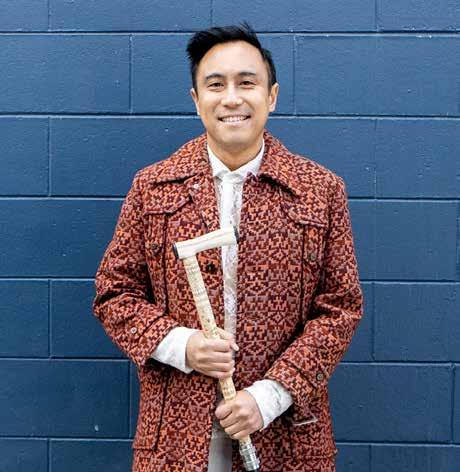
Poet Laureate and how much my work meant to them.
As much as I am self-deprecating and try to minimize my achievements, I do accept that me being Poet Laureate and being visible is actually important for a particular group of people who have never had that visibility in the arts or media.
What’s next for Chris Tse, Poet Laureate? I've got several invitations to do festivals and events, and I'm hoping that I can get a few more school workshops in while I'm still Poet Laureate. But a lot of that work will continue after I step down. I'm also going to start seriously working on my next book.
The 2024 Ōamaru Steampunk Festival is scheduled for King’s Birthday weekend.
ŌAMARU’S THRIVING steampunk subculture attracts enthusiasts from around the globe. In fact, Ōamaru was published in the Guinness World Records for the largest gathering of steampunks, at the 2016 Ōamaru Steampunk Festival.
The event is still going strong: 2024’s jam-packed itinerary includes a fashion showcase, a street parade, a steampunk ball and an R18 vaudeville variety show.
There’s opportunity for enthusiasts to meet each other and add to their collections, with markets and an op
shop tour. For the competitive, there is a chance to try their hand at parasol duelling and teapot racing.
New experiences this year include a trinket swap, a supper club with specials from local restaurants, and workshops and demonstrations through the Steampunk Academy.
For an unabashed celebration of the creative, the whimsical and the outlandish, head to Ōamaru over King’s Birthday weekend (May 30 to June 3). steampunk.org.nz

The MeloYelo Superlite is as light as carbon fibre but constructed from aircraft-grade aluminium.
DESIGNED AND ENGINEERED in New Zealand by MeloYelo, the Superlite weighs just 22kg. Despite being so light, it’s suitable for riding on New Zealand cycle trails up to Grade 3. The bike has a step-through frame, a high-power/high-torque Bafang M420 motor, a ten-speed Shimano Deore gear set, smooth air suspension, hydraulic brakes and a thumb throttle to provide a power boost once you’re riding above 6km/hour.
To be in to win, send your name and contact details to MeloYelo e-bike, AA Directions, PO Box 5, Auckland 1140 or enter online at aadirections.co.nz by May 31 2024.
Hamilton’s Mystery Creek is home to Fieldays, the largest agricultural event in the Southern Hemisphere.
FROM JUNE 12 TO 15, Fieldays will once again showcase the latest developments in agriculture, agtech and primary sector services. Attendees can expect to connect with industry experts and the rural community, gaining insights into the realworld challenges and solutions shaping the future of agriculture. Stalls include a Sustainability Hub, free health checks in the Fieldays Hauora Taiwhenua Health & Wellbeing Hub, career guidance in the Fieldays Careers Hub, and the latest rural tech options at Fieldays Digital Futures. Find out more and get your tickets at fieldays.co.nz


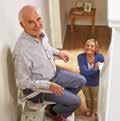
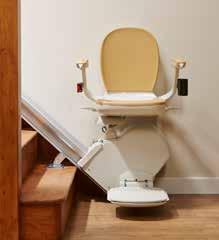

AT AUCKLAND MUSEUM from May 29 until October 13 you can immerse yourself in the surreal exhibition RELICS: A New World Rises which combines LEGO® with discarded human artefacts. Created by Australian LEGO® Masters winners Jackson Harvey and Alex Towler, the exhibition explores the creation of new civilisations grown from the shell of the old. Set in an imagined futurescape where humans have long since abandoned Earth, RELICS: A New World Rises includes a series of
whimsical and thought-provoking vignettes. LEGO® minifigures have reclaimed objects like a piano, an old refrigerator, a computer server and a vintage car in which to build their own miniature worlds. Full of intricate detail and hidden surprises, the exhibition is designed not only to surprise and delight, but also to provide a commentary on some of the topical issues facing the world today.
RELICS: A New World Rises explores an imagined future, one that might not be as far removed from reality as we think.
42 days, departs 16 May 2025
11 days, departs 23 Aug 2024
Early Bird Special. Book now, save $1,500 per couple
•
Package includes:
•
• Campground charges
•
•

Package includes:
• Return flights
• Comfortable Hotels
• Many meals
• Extensive sightseeing

Package includes:
• Vehicle rental
• Ford Mustang upgrade available
• Hotel accommodation
• Route 66 attractions
• Comprehensive tour notes


Swan Lake is dancing its way around New Zealand.
THE ROYAL New Zealand Ballet’s spell-binding Swan Lake is back for the first time in over 10 years. The beauty and romance of the greatest classical ballet takes centre stage with Aotearoa’s best ballet talent, accompanied by Tchaikovsky’s soaring score for an unforgettable night at the theatre. We’re celebrating by giving AA Members 15% off full price adult and child tickets on the best available seats to the performance of your choice. Purchase tickets online using code AAJETE2024
Swan Lake is touring nationally from May 1 to June 2. Catch the RNZB in Wellington, Auckland, Napier, Christchurch, Dunedin and Invercargill.
LOTS OF PRIZES are up for grabs in this issue.
• A MeloYelo Superlite e-bike valued at $5,695 is up for grabs. See p.13 for all the details on how to enter the competition.
• For the chance to experience Gisborne, enter the draw to win a getaway for two including two nights at Tatapouri Bay Accommodation, a Dive Tatapouri stingray experience, a Gisborne Railbike Adventure and a $50 voucher to spend at
Matawhero vineyard. Read about Gisborne from p.58; see p.60 for details on the prize.
• Featuring in our Meet the Maker series, Masterweave is a Wairarapa company making luxury blankets, throws and scarves from natural fibre. We have a Masterweave mohair throw to give away. Find details on how to enter the competition on p.73.
• See New Zealand by rail with a family pass for two adults and two children on any Great Journeys scenic train. Read about the Northern Explorer scenic train from p.52; see p.55 for prize details.

LATE LAST YEAR , AA policy researcher and AA Directions writer Peter King tragically died from a suspected heart attack.
Peter had been with the Association for 22 years and his name will be familiar to regular AA Directions readers. Over the past two decades, most editions have featured at least one of his articles and they were often the stories that engaged readers the most.
His writing was always insightful and focused on the human aspects of transport systems. Topics he’d written on recently included how we need to adapt our transport systems to cater for the growing number of older drivers; how drivers perceive risks; and the constraints that impact our daily transport choices.
He was a deep thinker with the technical skills to mine statistical data and the writing skills to turn it into meaningful messages for us all.
Peter’s articles were part of his wider job in the AA’s advocacy team where he did extensive Member surveying. He’s left behind a valuable database tracking changes in Members’ views on issues like transport costs, speed limits, cellphone use, and much more. He produced numerous policy think pieces and was also well-known in the transport research sector for his work with AA Research Foundation projects.
At his funeral, his colleagues and friends remembered him as an engaging, clever and caring friend and father, someone with a brain the size of a planet, who was always seeking new knowledge, was full of interesting conversation and ideas and had a youthful spirit.
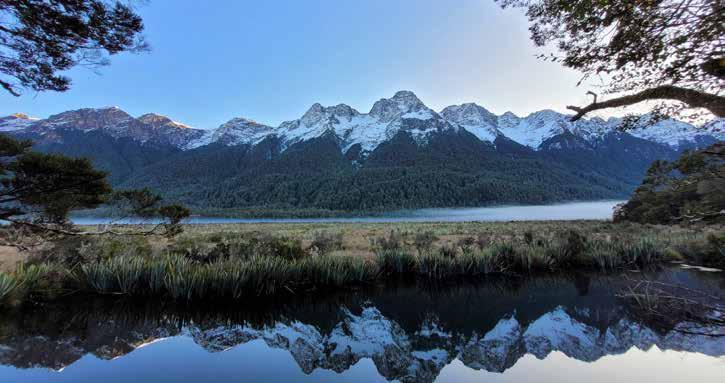
SOUND in Fiordland is one of New Zealand’s most remarkable natural wonders. However, increasing tourism to the area and along the Milford Road corridor has many concerned about mounting pressure on the region’s natural environment and limited infrastructure.
In the six years between 2012 and 2018 the number of visitors doubled from approximately 437,000 to 880,000. Many of these were daytrippers from Queenstown – spending eight hours of their day in a bus or car. As these visitor numbers rose, so did the pressure on the natural environment and limited infrastructure in the remote World Heritage Area. And numbers are predicted to continue to increase.
The Milford Opportunities Project, created by the Department of Conversation and Southland District Council, is exploring how to make the region’s tourism more sustainable.
Proposed measures include charging an entry for non-New Zealand residents, introducing low carbon buses and encouraging visitors to access guided tours rather than travel to the area by private car.
The project is now seeking feedback from New Zealanders. If you have feedback or would like to find out more, visit milfordopportunities.nz or get in touch at contactus@milfordopportunities.nz
Feedback is due by June 30, 2024.
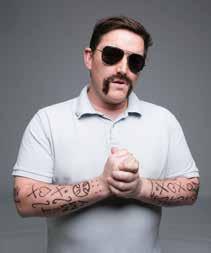
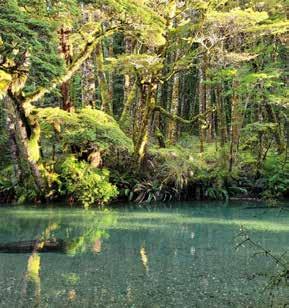
In need of a good giggle? Catch the New Zealand International Comedy Festival in Auckland and Wellington, from May 3 to 26.
SINCE HUMBLE BEGINNINGS in 1993, the New Zealand International Comedy Festival has blossomed into a major nationwide event, attended by over 100,000 people each year.
The 2024 line-up is looking promising, with a raft of local and international talent including Melanie Bracewell, Nazeem Hussain, Fern Brady and 2023’s festival winner of the Fred Award (Best Show),
Guy Montgomery. The festival’s biggest event is the 2024 Best Foods Comedy Gala, hosted by Chris Parker, which will see the likes of Heath Franklin’s Chopper, Brynley Stent, Pax Assadi, Abby Howells, Takashi Wakasugi, Hayley Sproull, He Huang, Alice Snedden, Rhys Mathewson and Eli Matthewson take the stage.
Find the full programme and buy tickets at comedyfestival.co.nz
Ways of knowing are explored in an exhibition at City Gallery Wellington.
MEMORY LINES brings together the work of five contemporary artists to consider the relationship between memory, knowledge and art-making.
Using photography, film, sculptural installation, textiles and paintings, the artists collectively question the definition of knowledge, how it is gathered and how it is preserved.
Featured artists include leading New Zealand photographer Fiona Clark; Rozana Lee, who considers the power of pattern, material and form to hold cultural memory; sound, sculpture and visual artist Sriwhana Spong, and installation artist Hōhua Thompson, whose work for this exhibition reflects on generational knowledge transmission, storytelling and kaitiakitanga.
Also featuring is Kirtika Kain, a Sydney-based painter who reflects on collective memories held across the Dalit diaspora. Her paintings incorporate pigment, beeswax, tar and gold to build an evocative and symbolic visual language.
The exhibition runs until June 30, 2024.














DRIVER LICENSING APPLICANTS presenting with the wrong identification is a challenge at AA Centres. Without the right ID, applications for driver licences can’t proceed. To avoid frustration, people are being urged to double-check that they have the right documents.
For driver licensing transactions, a current NZ passport or a NZ driver licence (including learner, restricted and full, current or no more than two years expired) is needed. It must be the actual passport or licence, as copies will not be accepted.
If applicants don’t have either of those, they should provide one primary document and one supporting document (see below). These also need to be originals; copies will not be accepted.
Primary documents: a NZ passport (no more than two years expired), a non-NZ passport (current or no more than two years expired), a NZ birth certificate issued after January 1, 1998 with ID number, a NZ firearms licence (current or no more than two years expired).
Supporting documents: a Kiwi Access Card, an overseas driver licence, a SuperGold Card, a Veteran SuperGold Card, a NZ Work photo ID, a NZ student photo ID, a Community Services Card, a Steps to Freedom Form, a utility bill (this can be digital), evidence of IRD number, a NZ bank statement (this can be digital).
If neither primary nor supporting document includes a photo, applicants will also need to complete the NZTA Waka Kotahi identity referee form, providing a passport-style photo and an identity declaration signed by an identity referee.
For those who don’t have the above documents, they can visit an AA Centre or AA Driver Licensing Agent for advice on next steps.
For the most up-to-date details and additional information for driver licensing ID, see nzta.govt.nz or contact the AA.
Visit aa.co.nz/identity-verification/id for more information about forms of identification.


Be ready with the right ID when applying for a driver licence. All lit up
WREATHS OF LIGHTS drape through trees. Colours dance against the darkening sky. As the sun dips below the horizon, a surreal dreamscape emerges.
The LUMA Southern Light Project, held in Queenstown Gardens, is nothing short of a spectacle. Interactive displays, light sculptures, performance artists, sonic environments – it’s a sensory experience of art and creativity. The organisers state their mission is to connect people, celebrate the nightscape and showcase local culture and commerce. Join the show for another instalment of discovery on the shores of Lake Queenstown over King’s Birthday weekend (May 30 to June 3).
See luma.nz for tickets.
This year’s Aotearoa Art Fair is under new ownership and in a new venue.
FROM APRIL 18 TO 21, the Viaduct Events Centre on Auckland’s waterfront will host the Aotearoa Art Fair, presenting a showcase of work from leading Australian and New Zealand galleries.
Forty gallery booths across two floors will feature painting, sculpture, print and ceramics from a plethora of established and emerging artists.
Now under the ownership of the organisers of international art fairs
Sydney Contemporary, Art SG, Taipei Dangdai, and Tokyo Gendai, the New Zealand event is set to shift up a gear, leveraging that international expertise.
Tickets are on sale now at artfair.co.nz
New Zealand’s largest literary celebration is once again packed with impressive, inspiring talent.
BOOK LOVERS will be engrossed in the Auckland Writer’s Festival this May 14 to 19, with this year’s programme featuring over 200 writers including some of the world’s best-known literary superstars.
Paul Lynch, the winner of the 2023 Booker Prize for his novel Prophet Song will attend, as will Ann Patchett, one of the world’s most acclaimed, prize-winning novelists and nonfiction writers. Celeste Ng, writer of Little Fires Everywhere and Our Missing Hearts is on the billing, plus Bonnie Garmus (Lessons in Chemistry), Anna Funder (Wifedom: Mrs Orwell’s Invisible Life) and Pulitzer Prize winner Viet Thanh Nguyen (The Sympathizer, A Man of Two Faces).
A number of top New Zealand writers are set to appear also, including Patricia Grace with her recent bestseller The Bird Child, Catherine Chidgey (Pet), Saraid de Silva (Amma), Emily Perkins (Lioness) and Becky Manuwatu (Auē). Comedian Dai Henwood, actor Sam Neill and ex-All Black Dan Carter are also booked to speak about their respective memoirs.
All events are live and in-person, presenting the invaluable opportunity to spend an hour with some of the world’s most celebrated writers.
Alongside author talks, guests are treated to panel discussions on everything from global politics and literary censorship to living a child-free lifestyle. Attendees will also find workshops, pop-up events and visual installations dotted around the city centre, including STREETSIDE, a night festival in Britomart featuring slam poets and readings.
Most major events are ticketed, but some of the programme is free entry, including the majority of the festival’s family programme (May 18-19).
Find the full programme and buy tickets at writersfestival.co.nz
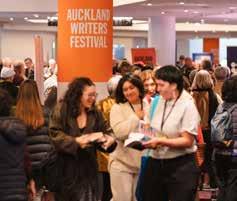


There are some jobs that are so filled with joy and fun they barely seem like work. Meet eight Kiwis who have found inspired ways to make a living.
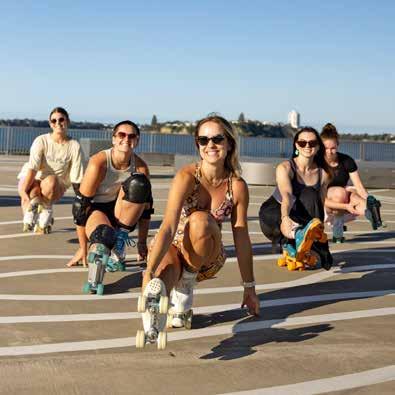
THE ARGENTINIAN-NATIVE picked up her first pair of skates at age four, and she’s been on a roll ever since.
After spending 11 years representing New Zealand as a professional artistic roller skater, winning numerous national and international titles, she started her own club – North Shore Artistic Roller Skating Club – and built a successful roller skating coaching business, Hey Macarena, from the ground up.
But choosing a non-mainstream sport in a rugby-mad country like New Zealand hasn’t been easy.
“When we moved to New Zealand in 2003, I wanted to keep skating. The only club available to us (in Auckland) was in Mount Wellington; we lived on the North Shore. My parents drove me there three times a week so I could skate.”
After professionally retiring in 2018, Macarena says the move into full-time coaching was a no-brainer.
“I was always going to be a coach. From when I was 14, I helped with the little kids learning to skate. I started
coaching privately when I was 16, mentored by my coaches. I chose a university degree in Sports Science and Psychology because I wanted to keep teaching and progressing.
“I started with teaching a Learn to Skate class at ActivZone in Glenfield (on the North Shore). And then it just got bigger and bigger. Soon, we had two classes and the kids wanted to compete. Then it was me and my sister teaching at our new club, with three or four classes going, and the kids just kept coming!”
Despite the rapid success of children’s coaching, Macarena wanted to branch into teaching adults.
“Before 2019, there was no space in New Zealand for adults to learn to skate. So, I just gave it a shot. I started posting about it on Instagram and people began showing up. Towards the end of 2019, it was starting to get quite big. The first time I hit 30 people, I was like, what the hell?”
However, when the pandemic hit, the numbers of interested skaters increased drastically.
“When lockdown happened, skating became really popular. It was a way to get outside and be active without having to be around others. But people were buying skates and they didn’t know how to use them. I started teaching on Instagram Live and making tutorials on how to start skating in a safe way.”
Despite missing teaching in person, there were some real benefits to leading classes online. “It meant I could teach anyone from anywhere. They didn’t have to be living in my city for me to give them tips or help them out.
“When we came out of lockdown, I started doing classes again and had 50 people showing up. It snowballed from there.”
In those early stages, it was the people surrounding her – including her mother who acted as her club’s secretary, and her sister, also a professional skater – who made success possible.
“Shout out to my mum! She does all the admin as a volunteer: replying to emails, sending out invoices, telling people what time the classes are. Without her, I wouldn't have a job.”
Macarena’s classes continue to attract large numbers of skaters of all different ages and skill levels. She credits much of this to the sport’s low barrier for entry.
“It’s an inclusive sport because it is individual. If you’re doing it as a hobby, you don’t have to be in a team or be a certain age or gender to take part. You can just buy a pair of skates and practice by yourself in a car park.”
So, what’s the future for roller skating in New Zealand? It depends on who you ask, she says.
“I don’t think the recreation movement is slowing down. There are more and more people joining roller skating clubs and lots of people who just do it casually. So many people just do it for fun.
“There are so many people who can skate now, and who want to take it up as a proper sport, which will make it become more mainstream. I think we’re going to get it into schools very soon.”
Jo Percival talks to Dr Martin Van Tiel, who creates some of New Zealand’s biggest fireworks displays.
WHEN IT COMES to exciting careers, it doesn’t get much better than blowing things up for a living.
Dr Martin Van Tiel is a pyrotechnics expert who has created some of New Zealand’s biggest and best fireworks displays as well as many of the dramatic explosions seen on our TV screens.
“My interest in chemistry started from a very young age,” Martin says. “I remember getting a little chemistry set for Christmas when I was about 10 years old. But the chemicals weren’t particularly explosive, so I researched and found which ones were more interesting for making pyrotechnics and rockets. The local chemist provided the appropriate chemicals –with a caution, of course!”
But despite a passion for pyrotechnics, even learning more about it was challenging, let alone turning it into a career.
“No one will teach you much about explosives!” Martin laughs. “My learning was self-taught throughout high school and university. At uni, access to information was easier, although details about explosives was still in secretive government documents. It would take months to get certain defence reports into the library. These days you have access to that information at your fingertips.”
After completing a PhD in chemistry and many years of experimentation and practice, Martin is truly an expert in what’s required to make things go bang. His company, Van Tiel Pyrotechnics, has been operating for 30 years.
“When we started out we were making our own pyrotechnics,” Martin says. “But these days we import most of them because of the costs involved. We just couldn’t compete. However, we still manufacture specialised pyrotechnics for large fireworks displays, for film and television, and we make rocket propellants for the New Zealand Rocketry Association.”
There are no dress rehearsals when it comes to fireworks displays, so having a comprehensive understanding of the components and performance of each pyrotechnic effect is critical.
“Every time we do a show, we analyse our choreography and creativity to improve the level of entertainment for the audience.
“It really comes down to years of experience and using good products.”
The Auckland millennium fireworks display was the company’s big break in the industry.
“We went from standard, small displays to international recognition as the first display in the world for the new millennium,” Martin says. “There was a lot of pressure and the weather was horrendous that night! But we’d prepped for nine months as we were using some of the biggest fireworks that we’d ever manufactured.
“The largest star shell we’ve ever fired in New Zealand was 60cm, which weighed 60kg. We had two of those in the millennium display and we’ve since used them in the Auckland Anniversary displays over the years.”
Fireworks are flowers in the night sky, traditionally described as peonies, chrysthanemums and dahlias. In 2011 the Rugby World Cup was another milestone when the world’s eyes were on New Zealand; it required an extra special display.
“We created special New Zealand-themed fireworks for that one – pōhutukawa and kōwhai flowers to be represented in the sky.”
Despite what you might think, pyrotechnics is not an entirely glamorous job. Fireworks are classified as explosives and are regulated out of necessity. “Paperwork and compliance is a huge part of our day-to-day work,” Martin says. “The glory is about 1%. But it’s enough to keep me going!”
Fireworks have been around for over 1,000 years, and they’re a reasonably green form of entertainment. “They only use a small amount of chemicals and most of those are fertilisers; the cardboard construction is biodegradable,” Martin explains.
But the best part of the job is people’s responses. The world loves fireworks – from jaw-dropping large-scale displays to childhood memories in the backyard. “As soon as you see them, you’re mesmerised,” Martin says. “I love the enjoyment that the crowd gets. It’s the magic of transforming ten minutes of people’s lives and creating something that will be a real highlight.”

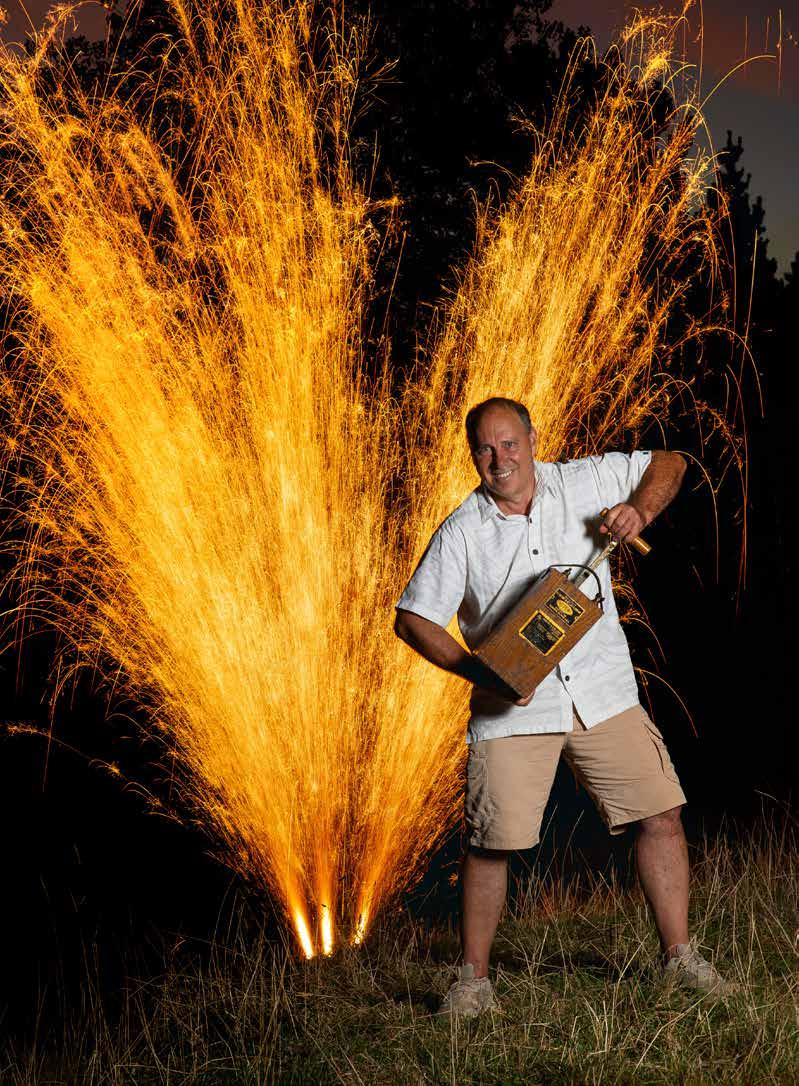
Emily Draper talks to Sue Court about her career as an equine therapist.
HORSES HAVE ALWAYS been close to Sue Court’s heart but it wasn’t until she was made redundant that she decided to turn her passion into a career.
After decades working as a professor of music and a classical guitarist, Sue retrained as a counsellor and joined her partner Sarah – also a trained counsellor – to establish EarthHorse, a small practice for equineassisted therapy.
In the picturesque Waitetuna Valley in rural Waikato, the EarthHorse 11-acre farm is home to a team of seven horses, including two miniatures. Here, Sue and Sarah offer a unique brand of counselling, working with a range of people with different needs.
“We have clients suffering from trauma, from sexual abuse, from depression and other mental health issues. We have clients who might feel as though they’ve lost their way in life… We can help with finding direction.
“Working with horses is also fantastic for people with autism, both young people and adults. I’ve had clients who initially couldn’t look another human in the eye. But when they realise they can have a direct relationship with a horse in a safe environment, they gradually learn to trust and communicate better.”
The structure of each session depends on the individual, and can include grooming and leading the horse around, or simply standing and observing its behaviour.
“Many people find it easier to make a connection with an animal than they do with a human. It provides a lovely healing environment for whatever a person is experiencing.
“Horses reflect the sort of issues that humans have in society, only they do it much more subtly and compassionately because they’ve evolved as herds. They’ve had to get on with each other in ways that human beings haven't quite mastered. We can see how they interact with each other in an honest and healthy way.”
The magic of horses, Sue asserts, lies in their unique ability to sense and reflect human emotions.
“They’re very sensitive creatures. As a prey animal living in a herd, they are constantly aware of everything in their environment. Their sense of smell is so much better than ours, like 40 times better. They’ve got nearly 360-degree vision, they can hear our heartbeats and they can smell adrenaline, so they can pick up on somebody who is pretending to be confident, but they're actually fearful inside. They’re like a perfect mirror.”
Because of this sensitivity, the horses often choose the clients, Sue says, rather than the other way around.
“We have one horse who lost her foal and was suffering from grief. She’s the one that will automatically approach a human with grief. She’ll always go to somebody who has lost a parent or had a miscarriage. They’re just willing to help, you know. They want others to feel good.”
Alongside individual therapy, Sue and Sarah also provide personal development, workshops, public presentations and professional training. Sue has noticed a recent increase in New Zealanders looking to become equine-assisted therapists.
“It’s definitely a growing thing. When I started out, I think there were one or two that I knew about in New Zealand. People would say, ‘equine assisted therapy? Are you giving your horse psychotherapy?’ Now people have heard about it.”
For Sue, there is no doubt that overhauling her career and lifestyle was the right decision.
“It’s been a life-changer. It really has. On a massive emotional and spiritual level as well, because when I work with a client, I also feel transformed. It’s such an honest connection with both an animal and a human being. It’s very beautiful work to do.”
 PHOTOGRAPH BY RUTH
PHOTOGRAPH BY RUTH
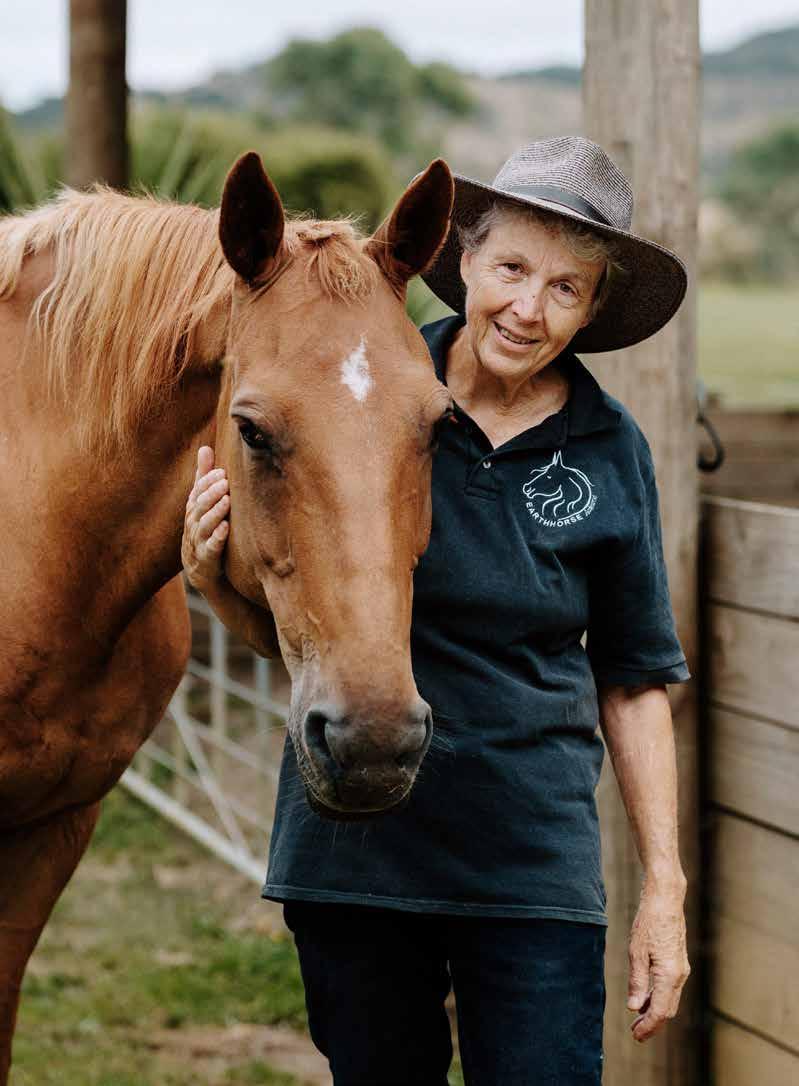
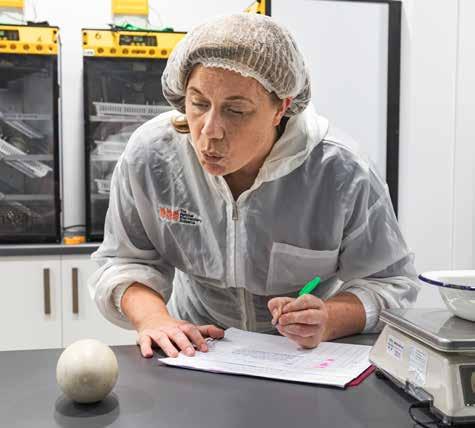
The kiwi seems a fragile species, but Emma points out they were doing fine before humans arrived.
“When our land mass broke off from Gondwanaland, it was literally birdland. It’s estimated there were around 12 million kiwi. That number is now closer to around 68,000,” she says. “Kiwi didn’t have to defend themselves against predators until humans came along.”
Newly hatched chicks weigh around 350 grams and get released into the wild after around five months.
“It’s emotional because you know you’re helping to save them,” Emma says. “We need to get them to three times their hatch weight, to a size we describe as ‘stoat-proof’ where they can defend themselves. We basically keep them safe when they’re most vulnerable.”
The survival rate for kiwi chicks hatched in the wild is a bleak 5% while those in Operation Nest Egg, as the programme is called, get a much brighter 65% chance of reaching adulthood.
“We are an eco-tourism organisation in its purist form. We’re not-for-profit and 100% of the ticket revenue goes straight back into the kiwi programme,” Emma says.
The Rotorua facility usually hatches about 120 kiwi each year. Last year, that number was 153 – the biggest year yet –and the recent move to a new premises has doubled capacity.
National Kiwi Hatchery manager Emma Bean reckons she has a dream job.
She talks with Debbie Griffiths.
WHEN PEOPLE ASK how they could also work with adorable baby kiwi, Emma apologises for what could be considered dark humour.
“We all joke that someone on the team would have to die,” she laughs. “It’s seriously so good. No one ever wants to leave. Someone retired and moved away recently, but they immediately got roped back into kiwi monitoring around their new home. We just love what we do so much.”
UK-born Emma always wanted to work with animals. She completed a biological sciences degree at Birmingham University and an undergraduate thesis in microbiology before finding work in conservation.
“I was lucky enough to work with elephants and gibbons in Thailand. When I got to New Zealand, I started with kiwi monitoring around Whanganui and visited the National Kiwi Hatchery in Rotorua as a geeky tourist. I had a camera around my neck, and I was
taking notes. They thought I was a reporter,” she laughs.
Emma was offered a volunteering position and applied for a full-time job covering maternity leave.
“I got it and, sixteen years later, I’m still here. The kiwi is a species that is biologically unique, and it’s really captured me from that perspective.”
One of Emma’s favourite parts of the job is candling an egg, where a light is shone to illuminate the embryo inside.
“I love it when I’m on the side of the glass with manuhiri (visitors), watching what we do. As part of the egg health check, we put the egg on the bench and whistle to it. The chick will move around, making the egg wobble. I look up to see people’s reactions. We’re mammals, so we’re used to babies, but we think of an egg as an ingredient in a recipe. There’s a lightbulb moment when people suddenly get why we’re being so careful: there’s a baby inside, so these eggs are precious.
“If I was to be run over by a bus tomorrow, I’d be okay with what I've done in life,” says Emma. “I can say I’ve hatched over 2,000 chicks, so to be able to put that on my headstone, yeah, I’d be pretty happy with that. It’s an absolute privilege.”

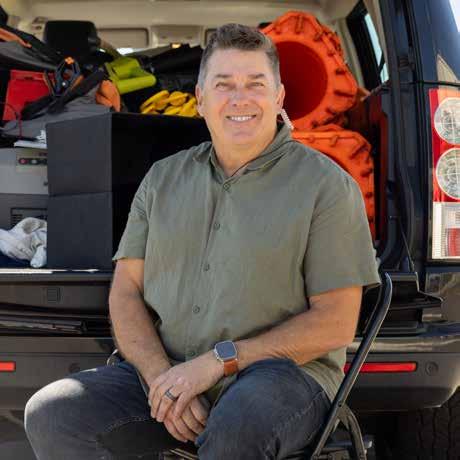
stage do I ever feel that I’ve really found it, until the potential locations become the 'selects', and then the selects get whittled down to 'confirmed'.”
As a location manager as well as scout, Drew’s job also involves ensuring a site is logistically suitable. “There might be 200 or so people on a shoot, so I have to be able to fit them, plus all the vehicles and equipment in there. That’s something I have to be mindful of when scouting – whatever I put forward must work logistically as well as visually.
“Plus, on a drama series or a film you could conceivably have 40 to 50 different locations, so for each of those I’d need to provide a range of four locations to choose from. It can be pretty full-on!”
A recent project Drew worked on was for an American brand looking for a frozen lake to feature in a TV commercial. “We shoot a lot of overseas ads in New Zealand, and this wasn’t for local broadcast,” Drew explains. “The production centred on an American skater being flown out for the filming.
Drew Stanton is a location scout whose job is to find places for film and television scenes. He talks to Jo Percival.
ONE OF THE KEY behind-the-scenes roles in the film and television industry is finding the places that appear on screen. Drew Stanton is a location scout, responsible for seeking out the landscapes, parks, gardens, streets and houses that form the settings for films and the backdrops of television commercials.
“I do scouting and location management for films, television, commercials and sometimes still photography,” Drew says.
Some of his credits include the TVNZ series Kura and an upcoming series with Warner Brothers, The Bishop, however a large portion of his work is TV advertising for major New Zealand and international brands.
“Television commercials and drama series have very different requirements,” Drew explains. “But generally speaking, I will get a creative brief from the director, then work with them to understand what they’re looking for and how they want each scene to play out.”
Armed with as much information as possible, Drew then begins the sometimes-daunting task of trying to find the perfect location.
“I liken it to chasing the white rabbit,” Drew laughs. “Even if I feel like I’ve found a location that’s exactly what they want, I still have to find multiple versions. I might think one spot is perfect, but the director loves a different one. And then the client might prefer a third option. So, at no
“I spent about five days looking for frozen lakes in the South Island and eventually found a spot near Naseby. However, after all that searching the American insurance people started worrying that the skater could potentially fall through the ice. So, we moved the shoot to the automotive testing ground in Cardrona Valley. There were concrete pads about the size of a football field that we flooded with 20cm of water, so below the ice was just concrete and the health and safety team were happy for it to proceed.”
As you would expect, Drew’s job involves a lot of time spent on the road. “I work out of my car extensively because I have to,” he says. “But New Zealand is a big place. I don’t just jump in my car and hope that I’ll find the perfect location. There’s a lot of preparation, research and groundwork that goes into scouting.
“New Zealand is remarkable. The number of times I’ve got to the end of a day on the road looking for spots, thinking ‘ah, I’ve had enough.’ Then I’ve gone around one more corner and suddenly there’s something that’s exactly what I’ve been looking for. Or even if it’s not quite perfect, I'm still surprised by what’s there.
“If you like being in a car a lot, it’s a great job! There are so many times when I think, ‘wow, this is crazy good!’”


Fiona
IT WAS THANKS to a book she bought for her son Sam that Flossie Pallesen found her destiny in life – as a professional balloon and bubble artist.
In fact, as a naturally shy person, she still can’t quite believe what she does for a living: putting herself centre stage in front of crowds at private parties and high-profile events. The former accounting clerk and veterinary nurse has become such a popular local character in the Nelson Tasman region that children recognise her and her vibrantly coloured hair wherever she goes.
“The balloon twisting book was the first thing I ever bought online,” says the mum of four and grandmother to three. “I’d wanted to find something to fire Sam up, a new hobby. I bought a pump and balloons, too.”
The pair set about making some of the creations in the book, starting with simple balloon dogs, flowers and swords, getting more ambitious as their skills progressed.
“Sam was only ten and really good at it straight away,” she says.
The book had suggestions on how to make money from the art, so the two decided to attend galas to raise cash for Flossie’s youngest daughter Mikaela’s school.
“People started asking me to do birthday parties. Then a couple of years later, while I was working as a receptionist at the local council, the person in charge of festivals said I could go along to some of their events. My first professional performance was for a council event at the Elma Turner Library in Nelson in 1990.”
Adding to her repertoire, Flossie responded to regular requests for face painting to accompany the balloon art, mastering a few colourful designs. Later, she added magic to her menu, having joined an online academy and taken part in workshops and courses.
“We’re not talking David Copperfield,” says the entertainer, who now goes by the name of Flossie Fizzberry and performs in 1950s-style dresses made from brightly patterned fabrics with full skirts and petticoats.
“The magic’s a bit of comedy. It helps create some wonderment with a playful spirit. My act is a kind of ‘magician in trouble,’ intentionally making very basic mistakes, which the kids enjoy telling me about – loudly! I love it when they laugh and they’re completely in uproar.”
The most recent addition to Flossie’s talents has been bubble art – a skill she mastered after she received a request to perform at the top of Botanical Hill, the Centre of New Zealand, for Nelson’s Lantern Parade.
“I did some online courses and spent a lot of time and money testing bubble recipes,” she recalls. “It worked so well. To be performing up on the hill as the sun set, with lanterns, bands playing, so many people dressed up and these enormous bubbles. It was just beautiful – magical in fact.”
One of her favourite tricks is to create a giant bubble dome or tube around a kneeling volunteer. There’s nothing better than the look of wonderment from the person inside, she says. Or the gasp from a child who catches sight of their face paint or the balloon animal she’s presented them with.
She’s performed as far afield as Hokitika and last summer became a regular attraction onboard the Interislander ferries between Picton and Wellington.
In 2010, Flossie gained the official qualification of Certified Balloon Artist, but it wasn’t until she attended a balloon twisters’ convention in Australia in 2013 that she proudly wrote her profession as ‘Children’s Entertainer’ on the official customs documentation for the first time.
“It makes for a good conversation, saying what I do,” she says. “I’m proud because I’ve done it completely off my own bat and it’s been driven by something I really love.”
The smiles of her audience make her heart sing. “That’s what’s always been the big motivator for me, to bring joy to others. It’s just lovely when people tell me, ‘this is the best thing that happened to me today,’ and I get told that quite often.”
Mark Harris is a professional stunt coordinator and stunt driver. He talks to Vanessa Trethewey.
IF FLYING THROUGH the Colombian jungle on a magic carpet, paddling a waka through the southern skies, or flooring it on icy roads in a muscle car sounds like heaven, it might be time for a new career.
West Auckland stunt coordinator and legendary stunt driver Mark Harris has done all that and more and, at 65 years of age – with 39 years of industry experience – he’s still going strong. Considered to be at the pinnacle of stunt driving in New Zealand, Mark’s list of credits include everything from The World’s Fastest Indian and Goodbye Pork Pie to Power Rangers, Xena and Hercules, and even Air New Zealand’s iconic ‘Flying Waka’ safety video.
“I was originally a mechanic with my own panelbeating and paint shop,” Mark says. “I was rally car driving, and someone got my name when they were looking for a stunt driver for the 1980s action movie Shaker Run. I knew nothing about the industry back then, but I ended up doubling for the lead actor, spending three months blasting around roads all over New Zealand at up to 190km/h in a replica Trans Am. That car went fast but it was a bucket of bolts to drive. It was old school, balls to the wall kind of stuff – every lad’s dream!”
The experience left Mark yearning for more, so eventually he wound up his business and devoted himself to full-time stunt work. Fast forward a few decades and you’ll find his adrenaline-fuelled magic sprinkled throughout more than 450 movies, TV shows and high-end action commercials, here and overseas.
“I’m very fortunate. I get to go to lots of awesome places and do lots of cool stuff. You don’t have to grow up in this industry – I’m a 65-year-old teenager!”
In the early 2000s, Mark set up his own company, Stunt Productions Ltd. As well as being the action man behind all of the daredevilry, he built up a bank of hightech equipment – from car rotisseries and driving pods, to rigging kits, ratchets and motion-controlled, high-speed winches. One of his favourite toys, the descender, allows performers and cameras to hurtle from cliffs and skyscraper buildings at realistic freefall speeds. He used the descender to shoot a cliff
diver in Hahei for a Camry commercial, which remains one of his all-time highlights.
His other favourite moment from decades of high-octane work is a stunt-heavy Samsung ad filmed many years ago at Te Henga Bethells Beach.
“I had to barrel along the beach and do a pipe ramp, and as my car hit the ground another car hit me in the side, so my car kept rolling down the beach. I was very pleased with how that one turned out – it was a great looking crash.”
But do the dangers of the job keep him awake at night? “Nah, I’m pretty confident with crashing a car, I’m well strapped in.” In fact, if you want to pursue a career as a stunt person, Mark reckons physical risks are the least of your worries.
“Yes, we have people hanging from cliffs hundreds of metres in the air, but we make the stunts so safe and there are many cables on them. Time restraints are a bigger concern, especially if I don’t have time to rehearse or test a new piece of machinery before I’m in front of a whole film crew with very expensive cameras. That can be pretty nerve-wracking. But in my job it’s very important to keep a calm mind.”
So what else does it take to make it in the industry? “A background in martial arts, parkour or dance is really good, and the right attitude. It’s not glamourous work. You might get into makeup at 5am and then spend the whole day waiting around to do your bit in the cold or the mud. The hours can be very long, but the upside is the variety. It’s good money, too. I make a lot of my income from my equipment, but when I’m performing stunts I also get stunt loading (aka danger money) to compensate for my discomfort.”
As far as careers go, Mark couldn’t imagine doing anything else.
“Lifestyle-wise, it’s a young guy’s dream. I go to a job in Fiji, for example, and I have my food and accommodation paid for, I get allowances and a good wage, and best of all, I’m doing something I love.”
And while Mark may no longer be a young man, thanks to a lifetime following his passion he is lucky enough to still feel like one.

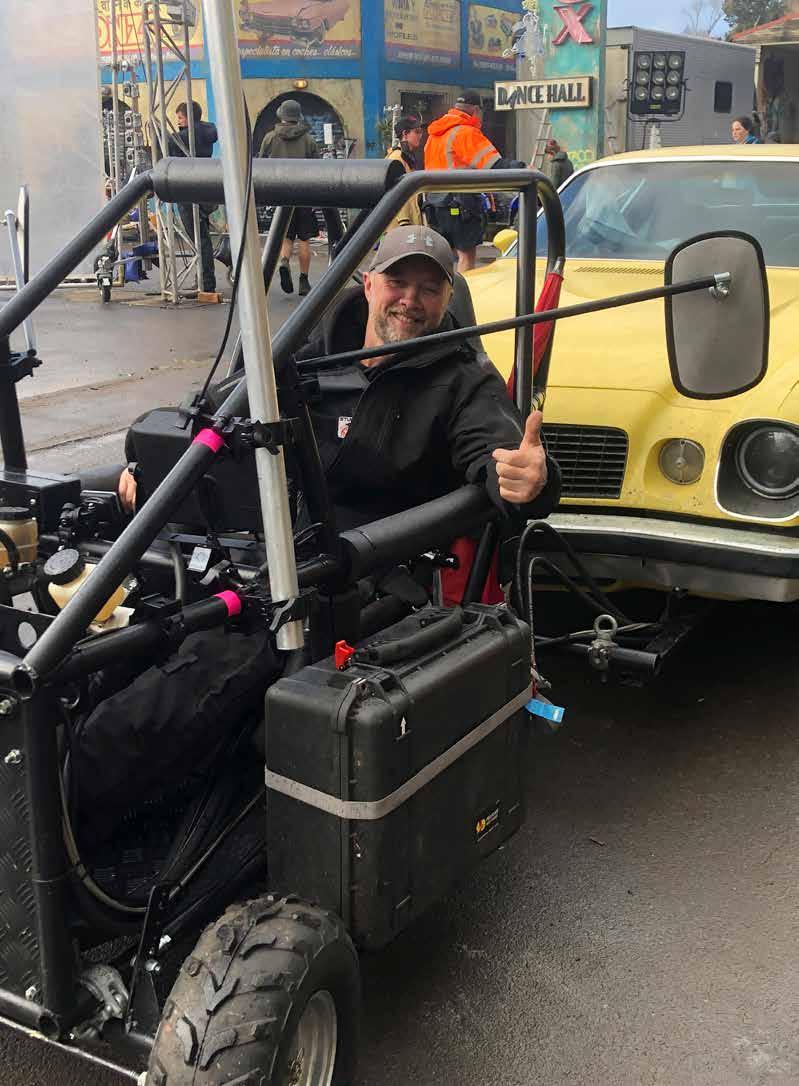
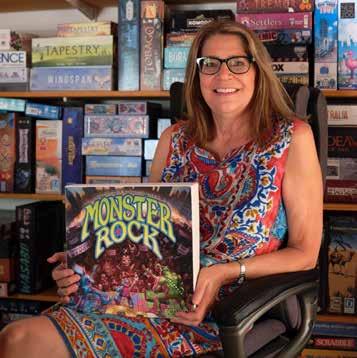
Debbie Griffiths talks to Amanda Milne, inventor of board games.
AMANDA MILNE is faced with a dilemma when she wakes each morning.
“I think: ‘should I do some work today, or should I just play a game?’ Then I realise that playing games is research, so it’s part of my job. I really love that.”
The Aucklander turned her lifelong passion into a business more than a decade ago. “SchilMil Games started because a friend of mine lost her job and I was working part time, so we’d get together to play board games,” Amanda says. “At some point, one of us said, ‘we could do better than this; why don’t we try designing our own games?’”
UK-born Amanda has degrees in geography and politics from Swansea University. She worked as a transport planner for London Underground for nine years and in clinical trials for Auckland University. At first glance, her earlier jobs seem unrelated to board game design.
“Both transport planning and medical research involve a lot of data collecting and problem solving. So does creating board games, so there is a common thread.”
SchilMil has ten games either in the market or in development. So, what is the recipe for a good board game?
“It depends on the audience,” Amanda says. “Kids like more luck than strategy in their games, while very hardcore gamers just want to puzzle it all out. For me, it’s a mixture of both: making the best tactical decisions based on your luck.”
In a saturated board game market, Amanda dares to take on the classics.
“Monopoly can last for hours and get pretty tedious. It usually ends with someone stealing all the money or upending the board,” she laughs. “The games I design have progression and you know it’s going to finish.”
There’s a sweet spot for how long a game should take: small card games around 20 to 30 minutes, while board games should ideally last 60 to 90 minutes.
“Since Covid, there have been more people wanting to get together face to face to play real games rather than looking at a screen. For a lot of people, it’s a way of socialising without having to make too much chit-chat. It allows introverts to be bold.”
Amanda's chosen career tends to be a conversation starter.
“I used to travel a lot for work, and at passport control they’d just stamp my arrival card and wave me through. Now it’s ‘game designer? Woah, that’s interesting.’ It’s a very different reaction.”
Amanda is eager to mentor designers and has written a ten-page introduction to the board game industry.
“I’ve met with people and played their prototypes to give them honest feedback. Here in New Zealand, it’s not a cut-throat industry. It’s genuinely about making the best games that we can. Getting noticed is quite difficult and we're all very small operators, so we help each other.”
Creating a board game from scratch takes time. It took Amanda five years to develop the board and cards for her latest creation, Monster Rock.
“I come up with an idea while driving or reading a book, and then I start by printing out cards with writing on them and doing a little bit of testing myself,” she explains. “I line up a couple of imaginary friends and play the game to see whether the mechanics work. Sometimes I shelve things at that point if it’s not working. I figure out the theme and make the mechanics fit, then I start playing it with people and making adjustments.”
The game artwork is then contracted out; for Monster Rock, Amanda hired university students to help.
“It was originally called ‘Stoned Age’ and was about a band moving around a city, writing songs and booking gigs. Because it involves different LP covers, it made sense to bring in a variety of artists and the students have been great to work with,” Amanda says. “Martin Wallace, a highly regarded game designer, tested it and suggested the fantasy elements, so now it’s a co-design with him. I’m really excited. I think it’s going to do well.”
To Amanda, game designing is simply a hobby that accidentally turned into a business.
“I wasn’t planning on publishing board games and co-designing with one of the rock stars of the board game world. That’s amazing. And I am proud. Sometimes I can’t quite believe that I get to make and play games every day.”
BUYING THE TRUCK was the best decision I ever made.
When I first got it, I had to take the gearbox out, change a bunch of bearings and learn to drive a manual. But it’s been satisfying doing some things on my own and saving some money on a mechanic, too.
I kitted it out straight away. It’s set up with a fridge, 12-volt solar panels, drawers – pretty much everything you need to live out of it, bar a toilet. And then I’ve got the
rooftop tent to sleep in. It’s pretty much in full-time camp mode.
People always say “I wish I could live the life you live.” And it’s like – you can! I am so broke. I’m just prioritising where I spend my money a little bit differently. Yeah, I wouldn't change a thing. I always say: I’m broke but stoked.
Read the full story at aadirections.co.nz

Transport Minister Simeon Brown reveals the Government’s next steps.
Under pressure Is congestion charging inevitable for our major cities? 40
In the hot seat We sit down with legendary F1 driving coach, Kiwi Rob Wilson.

Getting our roads sorted is critical to the economy, says the new Minister of Transport.
Simeon Brown holds many portfolios. As well as being responsible for Transport, the MP from Pakuranga is Minister for Auckland, Local Government and Energy. He talks with Dylan Thomsen about the key things he wants to make happen in transport.
What has been your favourite car?
I really like my current car, which is a Holden Equinox and I must say it is a pleasure to drive. It’s got plenty of space, I can tow things, it’s comfortable and it’s got a relatively powerful but efficient engine.
How would you describe yourself as a driver?
Ha ha. It’s a good question. I am a patient driver and I find it a pleasure. I don’t enjoy it so much when I’m sitting in traffic but generally, driving is something I love doing.
Apart from a car, how else do you and your family get around?
Primarily in a car. We’ve got three young children so that’s what works for us.
A lot of politicians these days get a lot of hate mail. How big an issue is this for you and how do you cope with it?
It has been an issue in the past. When I was the Police spokesperson for the National Party, I had threats and quite a bit of abuse from the gangs but it’s not something I’ve recently had to experience, thankfully. I get a lot of borderline trolling but I let it wash over me. I pay very little attention to what people say about me.
Did you want the Transport Portfolio and if so, why?
Absolutely. I think it’s one of the most exciting portfolios. It’s one of the most significant in terms of the opportunity to help grow the economy, to help people get to where they need to go
quickly and safely. Transport matters to everybody and there’s always something happening – every single day. From my perspective, it’s exciting. It’s about the future but it’s also very much day-to-day, so it keeps me very busy.
What do you see as the biggest challenge in transport for New Zealand right now?
I think the biggest challenge is making sure we are able to get back to delivering the infrastructure we need. A real focus on delivery, making sure we’ve got the funding and financing tools in place to ensure infrastructure is built on time. Also, a real focus on getting the basics right. It’s really easy to get distracted on things like light rail or big projects like that, but actually, fundamentally, a lot of Kiwis are saying we need to get the basics right and we need a real focus on delivery.
What about the biggest opportunity?
From my perspective, it’s the economic enablement that transport infrastructure can deliver for our country. We’re a small economy; we rely on being able to export our goods to the world. That means being able to have efficient, reliable, and safe connections across our country so we can move people and freight quickly and efficiently to where it needs to go. It’s about unlocking our economy, growing jobs and opportunities. Transport really is at the heart of that opportunity.
Your Government has declared a strong commitment to improving road maintenance. How long should people expect it to take until they notice the quality of roads improving?
This is going to be one of the big focus areas within the Government Policy Statement on transport. We’re going to be making it one of our priorities. There are decisions that still need to be made around funding and delivery but, ultimately, we want to have clear standards, clear expectations, and
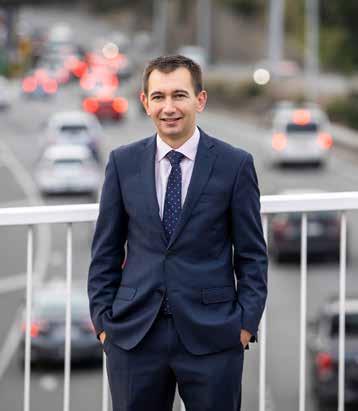
It’s really easy to get distracted on things like light rail or big projects like that but actually, fundamentally, a lot of Kiwis are saying we need to get the basics done right and we need a real focus on delivery.
outcomes. Then it’s our role to hold to account both NZTA (NZ Transport Agency Waka Kotahi) and local roading authorities to actually deliver those outcomes. We see that as flowing through into the system very quickly but, at the same time, we acknowledge that there are some significant challenges to our roading network, and so there is going to be a lot of work over a number of years to improve quality.
You’ve identified a lot of new roading projects around the country that you want to build, but the briefings for you as the new Transport Minister say the budget and workforce capacity are severely stretched. How will you look to deliver these projects given those challenges?
We’ve been very clear as a Government that we need to look at a range of new funding and financing options to build the infrastructure we need as a country. Whether that’s PPPs (public-private partnerships), tolls, or value-capture tools… We need to be taking a much more innovative approach to the funding of major infrastructure projects. Alongside that is the conversation about capability. We need to set a clear pipeline to attract capability and investment into the country. Over time, that pipeline will help to drive a far more efficient spend. It’ll bring in new funding and financing tools; it will also bring in critical capability to unlock that investment. So yes, the briefings to the incoming Ministers painted a very challenging picture, but we're setting a very clear direction, so that we can drive investment and build capability to meet the needs of the country.
Do you think there’s a risk that everyone across the country will want those projects to happen all at once, when in reality they’re going to happen over a period of time?
Our policy that we took to the election indicated that. It was a 10-year pipeline of projects; we’ve made it clear that this is about setting a direction of where we see the next ‘roads of national significance’ to be. Those projects are across the North Island and South Island, connecting our cities and regions. We need to build the capability to deliver it and we need to have the funding and financing tools in place to get those projects delivered. It will take time, but we’re committed to putting in place the foundations to get that programme underway.
You’ve faced some strong criticism in certain quarters that things like the removal of the subsidy for electric vehicles or any reduction in funding for public transport and cycleways will be a major blow for New Zealand’s progress on making transport greener. How would you respond to that?
I disagree with that criticism. Ultimately the ‘ute tax’ clean car discount scheme was relying on hundreds of millions of dollars in subsidies from the taxpayer. We didn’t agree that people should be penalised for buying a ute, when they don’t have a choice around what kind of car they need, in order to subsidise someone who has got a choice. So, we stand by those policies. But we’re confident that we’re going to see significant change in the make-up of our fleet, as car manufacturers convert to electric. We’ll support that change through increasing the number of public EV chargers, which is a priority for our Government. Also, the price point will continue to drop, which is exactly what we’re seeing now, meaning a subsidy is no longer needed.
On the other point, people have choices. The vast majority of people drive to get to where they need to go. It’s really important that we provide the infrastructure for people to get to where they’re going, quickly and safely. And that means making sure our roading network is as efficient as possible. That’s where our priority is going to be.
Your Government seems very supportive of introducing congestion charging in some New Zealand cities. When do you think that could actually be in place?
We are supportive of time-of-use charging. It’s about making sure we get the most out of existing infrastructure and make sure it’s operating as efficiently as possible. We’re currently getting policy advice on that and then that will feed into a legislative programme once that’s approved. It’s in the coalition agreement between us and ACT; we’re very supportive of it. We’re taking some early decisions soon and we’ll have more to say once those decisions have been made.
What is the issue or issues that people raise with you most often?
There are two key issues in transport: one is that we need to have a focus on delivery. That means having a clear pipeline of infrastructure and a focus on getting it done. There’s frustration that it hasn’t been the focus over the last six years. The other is making sure the roading network is being maintained to an appropriate standard. Those are two of my key focus areas which we’re working on through the GPS (Government Policy Statement), which sets out transport priorities and available funding for the next three years.

Emily Draper test rides what is described as the SUV of e-bikes.
Like many commuters, I’ve traded in bumper-to-bumper traffic for a helmet and two wheels. I love my e-bike: it gets me to work much quicker than any alternative, and being out in the fresh air is a great way to start and end the day.
So, when the team at Sinch Bikes offered a trial of their new, New Zealandmade Force EZ Belt model, I put my hand up.
The Force EZ Belt is a wholly different type of e-bike than what I’m used to. It’s described as a SUV e-bike: sporty to look at with a sleek, white design, perfect for both commuting and weekend adventures. Riding it along Auckland’s Northwestern Cycleway, I’m taken
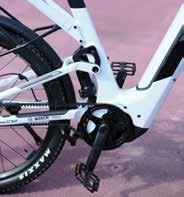
by how smoothly it rides. While my normal bike is clunky through gear and speed changes, the stepless automatic technology means there’s no changing gears; I can concentrate entirely on enjoying my journey, gliding up and down hills with ease.
The bike comes with four speed options, with a screen that displays the distance capacity at each level. Eco is great for saving power, Auto is good on flat terrain, while Sport is better for tackling steep hills. If you’re a bit of a speed demon, crank it up to Turbo and feel yourself fly.
Charging is also a breeze, with a detachable battery cover that magnetises to the side of the metal frame. But I don’t
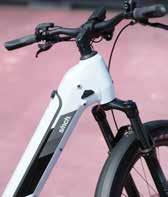
have to charge often, as the removable battery holds power well.
On the weekend, I take it out for a longer cruise. It’s here that the suspension and large step-through frame really shines. The lowest seat height on the medium sized model works for me, with a toggle on the handlebars that moves the seat up and down while I ride making adjustments easy.
All the bells and whistles do mean the bike is on the heavier side, something to be aware of should you have to manoeuvre it up steps at any point.
Even so, after a week with the Force EZ, it’s hard to return to my old e-bike. I’ll keep it in mind next time I’m in the market for new wheels.


Will we soon be paying to drive on certain roads in our major cities?
Matt Tso talks to the fans and sceptics of congestion charging.
For years, tolls to reduce demand for our increasingly jammed roads have been mooted, but so far have come to naught. But congestion charging talks are back on the table for two of the country’s economic hubs – Auckland, where over a quarter of New Zealand’s population lives and Tauranga, home to New Zealand’s biggest port.
Last year Auckland Council voted to develop a ‘time of use charging’ system, where motorists would be charged during peak hours on routes into the central city. If agreement can be reached with Central
Government, the toll could be in place as early as 2025 or 2026.
Snarled-up roads are frustrating and time-consuming. They also lead to lost income, heightened stress and increased pollution. Auckland’s congestion alone is estimated to cost the economy over $1 billion each year.
Congestion charging has been successfully introduced in Singapore, Stockholm and London. These systems rely on a toll to remove some vehicles from the roads; motorists who can change when, where or how they travel
have a financial incentive to do so, to avoid the charge. Congestion is reduced for those who continue to drive, making their trips quicker and travel times more reliable. Congestion charging has cut traffic volumes by between 30% and 50% in Singapore and Stockholm.
The New Zealand Infrastructure Commission Te Waihanga’s General Manager of Strategy, Geoff Cooper, says travel times have increased over the last 30 years, but trying to build a way out of congestion without other traffic management mechanisms is a losing battle.
“The fundamental law of roading congestion is increased capacity results in more people wanting to use it.”
The time-honoured method of dealing with congestion is to build more roads, but traditional funding sources – Fuel Excise Duty and Road User Charges – have proved insufficient to keep existing roads in good condition, let alone build more.
Tauranga City Council Commissioner Stephen Selwood says the case for congestion charging in New Zealand is strong – to both reduce traffic and to create a revenue stream for transport funding.
“We can improve the system at the same time. People pay for a faster trip
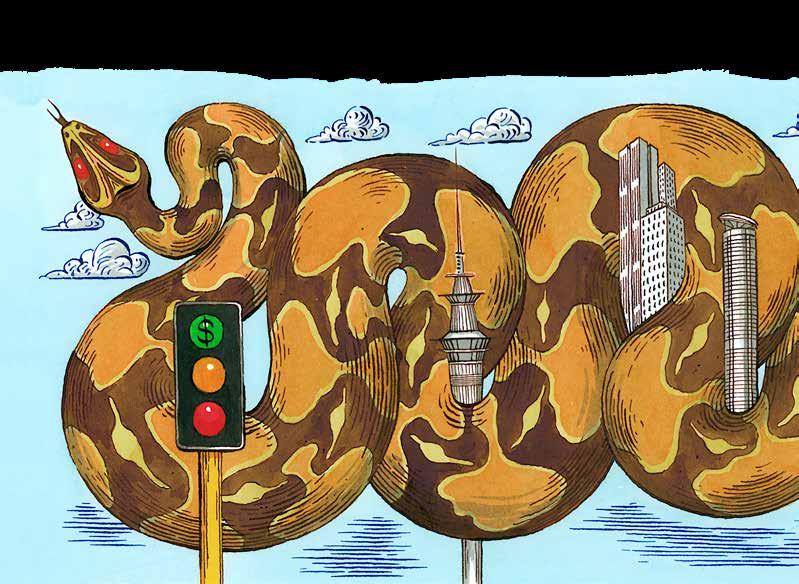
and also get a better transport system,” he says. But, he says, it’s important that the benefits in time and convenience exceed the price.
Congestion charging has also raised questions over equity, with sceptics concerned that tolls disproportionately affect people on lower incomes.
E tū Union Organiser Mat Danaher says congestion charging would force people to choose between money and time and it would be bad for workers, many of whom can’t work from home.
“If it takes the same form as in London, people would be paying $20 to $100 a week to go to work. Others could be forced off the motorways and onto crowded local roads to avoid paying.”
To stop fees becoming burdensome, most overseas models include a daily cap on charges. Mat says people like home support workers call in on several clients a day and it would be unfair for them to be charged while passing in and out of the toll zone.
Congestion charging could see the union bargaining with employers to cover the cost, which would eventually be reflected in the price of things like healthcare, food and manufactured goods.
Auckland’s Maungakiekie-Tāmaki Ward councillor Josephine Bartley voted in favour of the latest resolution because it included provision to look at equity issues. She previously opposed congestion charging because she felt it would unfairly penalise working people.
“My hope is that they look at exceptions – and not just Community Services Card holders. There are a lot of people, like cleaners, who need to drive to work. Even people on middle incomes are struggling.”
Stephen Selwood says number plate recognition technology based on age, income or occupation could be used to provide dispensation.
When it comes down to it, Geoff Cooper says decision makers shouldn’t let the perfect be the enemy of the good. “Everywhere congestion charging plans have been implemented... none are rigid. The system is always evolving.”
AA Policy Director Martin Glynn says congestion is forecast to get worse in our biggest and fastest-growing cities, and it's not a problem that can be solved with more roads.
“While road improvements must continue as an important part of keeping
our cities moving, major expansion of urban road networks is not considered a viable response,” Martin says. “And while improvements to public transport will give more people alternative ways to get around, the vast majority will continue to rely on their cars for the foreseeable future.”
While charging has reduced congestion overseas, those cities are much denser with public transport networks that offer a genuine alternative to car trips.
“Several key questions need to be answered of any proposal: which parts of a city will be subject to a congestion charge, how much will it be, and at what times of day will it apply? What will that mean for traffic in the rest of the city? What can those paying the charge expect in return in terms of reduced travel time and more reliable trips? What alternatives will be available to those who can’t or don't want to pay the charge? Will there be any exemptions or discounts? What will the money raised be spent on?”
If New Zealand wants to implement congestion charging in any of our cities, decision makers need to develop a fair and affordable scheme and provide clear answers to these questions.
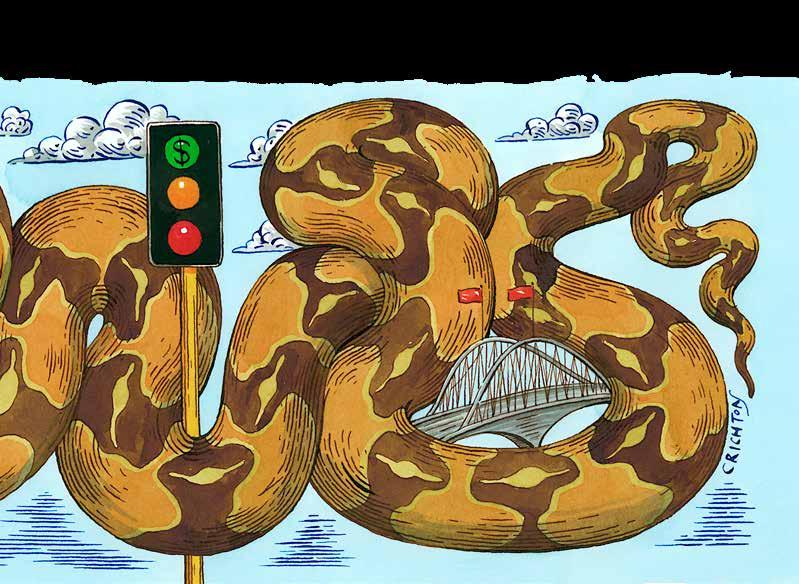
Rob Wilson grew up in Huapai, north of Auckland, and made a name for himself as a racing driver in England and the US. Today, he is revered on the world stage as a UK-based driving coach. Andrew Kerr caught up with the 71-year-old, who remains at the pinnacle of motorsport.
ho taught you to drive?
WI don’t think I was ever taught. I sat beside, or on the knee of, my father Bob and steered our 1938 Ford Standard V8 from the age of five or six. That was in the late 1950s.
By 1963, we owned a 1954 Humber Mk7. My father played alto saxophone and piano in a Saturday night dance band. On these occasions I would drive him home in the Humber under the cover of darkness from somewhere like Helensville. I would have been 11 years old and had naturally mastered heel-and-toe gear changes.
What are your first motorsport memories?
Listening to a radio report about the 1961 New Zealand Grand Prix at Ardmore with mentions of ‘Jack Brabham’s rear overtaking his front.’ My true interest began in mid-1964 after reading a Bruce McLaren column in the Auckland Star Bruce was coasting to the finish line in the Belgian GP, out of fuel, saying to himself, “I’ve won a Grand Prix!” However, the previously pit-stopped Jim Clark roared past to take the chequered flag. What caught my interest was the exclamation mark in Bruce’s statement. As New Zealand’s greatest driver, I just assumed he won all the time.
What kickstarted your career in motorsport?
I talked my father into taking me to the Wills six-hour endurance race at
Pukekohe. Victory went to Jim Palmer and Paul Fahey driving a Lotus Cortin; soon after I got to meet Paul through a family connection.
Was there a point when you felt your driving ability really start to evolve? By the end of 1980, I had scraped a couple of wins in Formula 3, and I held a Formula 1 Super Licence throughout the 1980s. You would assume this to be a personal peak driving period, but I tended to rely upon car control to find gains in ‘dangerous’ faster corners.
At the end of 1988 I raced a singleseater at Tamiami Park, an unexciting circuit in Florida, and winning that race opened up another world. It forced me to become an expert on chicane-type corners and ‘slow in, fast out’ bends.
The second key moment was about 10 years ago when, while training people, I identified a magic rate of input as drivers use their hands and feet to transfer the weight through a car, effectively communicating with the surface through steering and brakes. It’s an ongoing obsession.
When did coaching for the top echelon of drivers become ‘a thing’?
I think F1 coaching began seeping through in the early 1990s when some of the F3 drivers I was training made it into F1. A pivotal moment was when I coached [subsequent F1 champion] Kimi Räikkönen in the early 2000s. Since then I have worked with roughly half of the F1
grid. There are 11 drivers in the current field who I am working or have worked with. And I trained 20 of the V8 Supercars drivers in last year's Bathurst 1000, including a couple of recent retirees.
What is the thinking behind your backto-basics driver training in a regular road car?
A normal road car (currently a Ford Puma) is the ideal vehicle for highlighting driver inputs as it produces pronounced car movements. I have spent time with trainees in every conceivable vehicle with two seats, but the exceptional tyre grip and downforce of Ferraris or Porsches can obscure inputs.
The physics are the same in a normal road car (driven without helmets but against the stopwatch). It offers a quieter environment and there’s room for engineers in the back seat. It is a more intimate experience and one-on-one dialogue is much clearer – even mid-corner!
As a coach, how long does it usually take you to identify room for improvement?
I can identify where there is room for improvement within three minutes, or by the end of the second lap when I am in the passenger seat. Working out how to articulate this to the driver could take 30 to 45 minutes. Getting the driver to perform at their maximum can take anywhere from three days to three years, or more. The variation is massive. I have spent more than 100 days with some
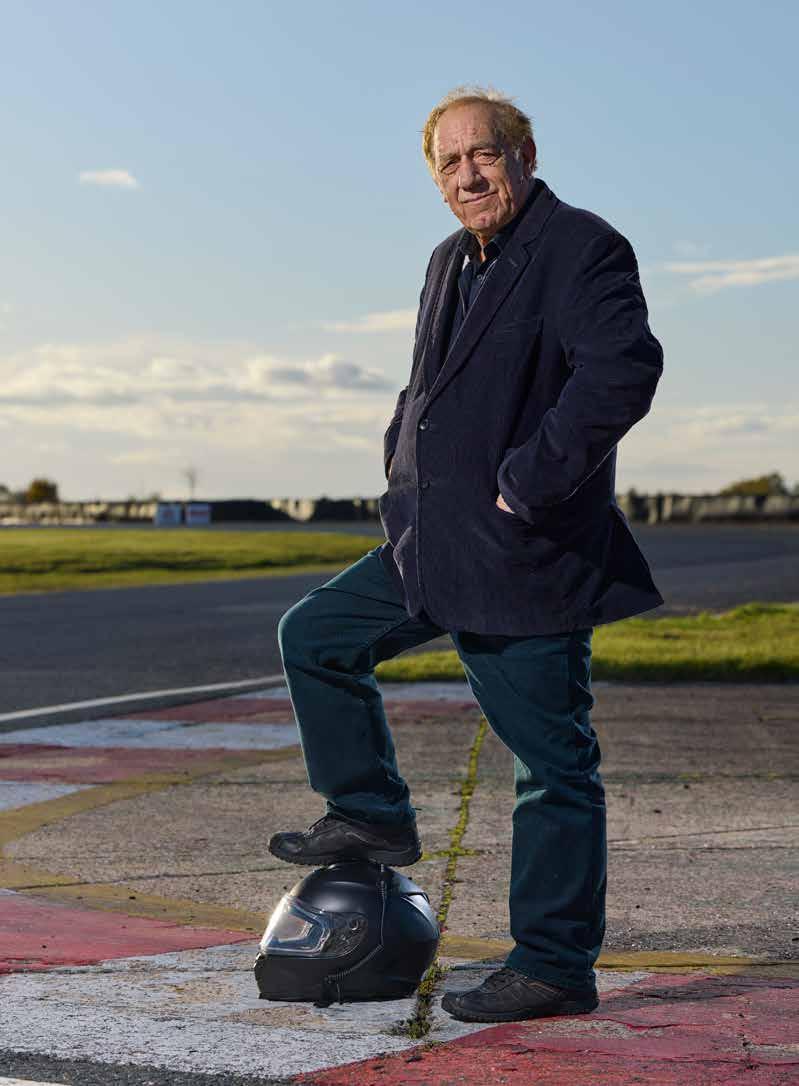
drivers who you may have heard of. With others, it can be done in a week. I can explain and demonstrate – and they will listen – but it is not until they experience it firsthand that the ‘light bulb’ learning experience really begins.
Can you pinpoint areas in which you’ve had significant influence on successful racing drivers?
Of the numerous areas I work on, a key skill is getting the lateral (sideways) load out of the car for faster acceleration out of corners. This can be achieved with a variety of methods; additional rotation mid-corner isn’t only achieved by more steering and the brake pedal is not just for slowing the car down; it has many uses. Being able to release the steering very slightly also reduces tyre degradation. With the above in mind, one must recognise there are some corners which simply require an ideal geometric line.
Do you have a strong sense of what a driver is experiencing at the wheel of a modern F1 car?
I can extrapolate from the drivers what it feels like. The driving days I share with them are long and intimate, and the physics and dynamics are the same, as is the way they drive. The limit is the limit. For reference, I have lapped Indianapolis at a 225mph (362km/h) average in a beautiful-handling Foyt-Lola and found an ill-handling Formula Ford to be more demanding on a tighter circuit.
Why do you think our drivers are so well represented in top motorsport ranks?
New Zealanders have traditionally travelled a long way to Europe or the US to achieve their ambitions. It’s well documented that if a Kiwi arrived at Bruce McLaren’s workshop in the 1960s, having lumped their own toolbox 12,000 miles (probably on a boat), they were pretty much guaranteed a job. I find this ‘have a go’ attitude is still etched into the Kiwi mentality.
And, as drivers, many Kiwis grew up drifting around unsealed dirt roads, developing car control fundamentals in the process.
When training top drivers, it certainly helps to be easy of address in a fairly highpressure situation, and we all know this is often the style of folk from Down Under.

I can identify where there is room for improvement within three minutes, or by the end of the second lap when I am in the passenger seat.
If you had 30 minutes with a novice racing driver, what would you focus on to make a lasting impression?
I would use a manual gearshift car, teaching them to ‘heel and toe’ for the braking / downshift procedure, even if every car they intend to race has a paddle shift. It makes the driver bump sensitive. And I would teach them the value of creating some harmony with the track surface in the way they steer and operate the pedals while emphasising it has to be done with energy. The stopwatch will be running; it’s a very good lie detector!
Being a good on-road driver is arguably increasingly rare in New Zealand. Any tips to motivate people to become one? Meaningful fuel savings can be found by observing and anticipating traffic flow. On motorways, reading the ‘body language’ of cars up ahead pays dividends when you can orchestrate smooth overtakes. Also, when there’s a traffic delay, the big frustration is usually our expectations
not the traffic. I advocate switching to time mode rather than distance. Glance at the clock, give yourself five minutes, and you might be surprised by how far up the road you move. Were they the final five minutes of your life, time would pass very quickly.
What driving traits do you value most when you’re in the passenger seat?
Relaxed hands and feet allow your physical joints to act as shock absorbers, reducing negative resonance and enabling smoother driving. Good awareness of the surface you are driving on is also valuable.
Is the demise of the manual gearbox something to lament?
Yes. Hazel Jensen, the late wife of great New Zealand racing driver Ross Jensen, said to me 40 years ago: “With an automatic you are always in the wrong gear.” Transmissions have improved since then, but I thought she put it quite well!
Professional drivers don’t just know how to drive a car well, they also know how to control their emotions when they’re behind the wheel.
That’s why, when another motorist does something incompetent, forcing a professional driver to swerve or brake to avoid them, the professional doesn’t get angry, blasting the horn or winding down the window to yell at the offender. They just raise their eyebrows and continue driving.
By remaining calm in annoying traffic situations, you stop emotions from affecting your driving. When you drive angry, your driving becomes more aggressive, and you can make rash decisions. And that’s dangerous.
There are four ways that emotions can affect you when you are driving:
• You can have tunnel vision and be less likely to notice things happening around your car.
• Your reaction times are slower, affecting your precision and skills that need a quick response.
• Strong emotions can reduce your ability to accurately predict risky situations, as you feel detached from your surroundings. This can cause you to act aggressively and make dangerous decisions.
• You are more likely to experience road rage, which can lead to accumulating negative events.
The secret to remaining calm when others around you are driving like idiots is to remember that you are sharing the road with a cross-section of society – the elderly, young, sick, hard of hearing, mentally unwell, business people, criminals and police officers –sometimes in unmarked cars.
And it pays to remember that people can simply make mistakes.
If you understand that people are fallible, you can keep those dangerous emotions in check. That’s important, as strong emotions – from happiness to sadness to anger – can impair a driver’s decisionmaking skills and cognition.
But emotional control is a difficult skill to learn.
The key is to get into professional driving mode as soon as you get in the car. Settle into the driver’s seat and take four deep breaths to ground yourself. Wait to allow the engine to warm up or, if you are driving an EV, check everything is working as it should and the windows are clean. If you like to listen to music while driving, sort that out before you take off.
Once you’re underway, don’t expect politeness from other drivers. People can become quite isolated in a car and, with it, inconsiderate. Psychologists say that drivers can develop a sense of anonymity and detachment in the confines of their vehicles.
In traffic conflict situations, keep in mind that one of the following most likely applies: the other driver is incompetent (and there is little you can do to fix that); the other driver has simply made a mistake (and we all make mistakes); or the other driver is a bad, aggressive driver.
Even if it’s the case that the other driver is simply a bad, aggressive driver, chances are they’ll do the same to others and, sooner than later, they’ll be spotted by a police officer in an unmarked car.
Just remember, staying calm while driving helps you to stay safe. That’s what counts.
Comfortable, good-looking and with plenty of extras, the Subaru Crosstrek is a hybrid that performs well both on- and off-road. It’s had a cosmetic overhaul, with changes to its front view and wheel arches giving it a more rugged look and boosting the impression of size. With a 2L direct injection, horizontally opposed (e-boxer) four-cylinder petrol engine and electric motor providing an extra 12.3kW and 66Nm of torque, the difference between this and the non-hybrid model is difficult to feel, which is impressive. As with all Subarus, symmetrical all-wheel drive is standard. Safety features are also typically innovative, including Eyesight Clever Crash Avoidance technology. Price is $51,990 (plus ORC).


This trailblazing icon oozes multi-generational street appeal. In its sixth generation, it continues to give the kind of endorphin rush usually reserved for sports cars triple the price. Its muscular features, massive rear wing and triple exhaust give it a track-ready vibe, but the Civic’s also comfortable at 50km/h. It’s a cinch – and a joy – to drive in any traffic conditions. And because it’s a manual, with short-throw, low-friction access to a six-speed gearbox (all precise upshifts and rev-matching downshifts) it’s fun. The Civic has three modes: Comfort, Sport and +R, plus settings to modify suspension dampening, engine sound, display set-up and rev matching intensity. Base price is $72,000.
The MG4 has been scooping up global awards as it cements its position as an affordable EV. MG has pushed the boundaries of innovation and design here, combining sleek lines and panels with an active grille, unique rear spoiler and tail-light cluster to create a genuine sense of style. And it also has substance, accelerating in (a claimed) 7.2 seconds from 0-100km/h. The rear-wheel drive configuration, 50:50 weight distribution and lower centre of gravity contribute to agile handling and a comfortable, stable ride. With a seven-year unlimited warranty, including for the battery, and a 435km range, this small EV is a good option. It has a 5-Star ANCAP rating; entry price is $54,995.


The BYD Seal ticks all the boxes: range, value, safety, intuitive features and positive customer experience. It’s also very driveable, with dual motors delivering 390kW and 670Nm of power. Responsive steering and suspension provide composed cornering. Safety, comfort and handling are all elevated through dynamic, high-tech electronics. The interior is a cocoon of delight. From the quilted faux-leather seats and faux-crystal gear shift, to a multi-function heads-up display, everything about this cabin screams cool. The Seal range available in New Zealand consists of three models –Dynamic, Premium and Performance AWD. Prices range from $62,990 (+ORC) to $83,990 (+ORC) and battery ranges from 460km to 570km. All models have 5-Star ANCAP Safety Ratings.
At a whopping 5.3m long, just over two metres wide and 1.9m high, the driver (and all seven passengers) will feel utterly safe in the Land Rover Defender 130. And while inner-city parking could prove challenging, the 130 is not short of helpful technology. The SE and HSE models both run Land Rover’s D300 3.0L twin turbo six-cylinder diesel, 221kW with 650Nm of torque, 48V mildhybrid, eight-speed automatic. Fuel economy is rated at 9.4l/100km and towing capacity on the 130 is rated at 3,000kg. Currently, the 130 is only offered with diesel powertrains. Pricing starts from $160,000 for the SE spec, with optional upgrades available.

Hyundai’s updated Kona comes with various powertrains including internal combustion, hybrid and all-electric (on its way soon), all boasting significantly more space and new features. The new Kona Active 1.6 GDi hybrid 2WD has a six-speed dual clutch transmission, producing 104kW of power and torque of 265Nm, providing an accredited 4.3l/100km. Not bad! It’s 30mm taller and 145mm longer than the previous models and with a 60mm longer wheelbase, the difference will be evident to Hyundai drivers. Priced from $52,990 (plus ORC), this is an excellent option for those in the market for a mid-size SUV.

For full reviews see aa.co.nz/cars/car reviews
The AA Motoring Services team test-drives new models and makes of car. Their detailed, impartial reports are available at aa.co.nz/cars , along with ANCAP safety ratings.
Fuel economy ratings are available for these models. To compare fuel economy and safety ratings across other vehicles, go to rightcar.govt.nz
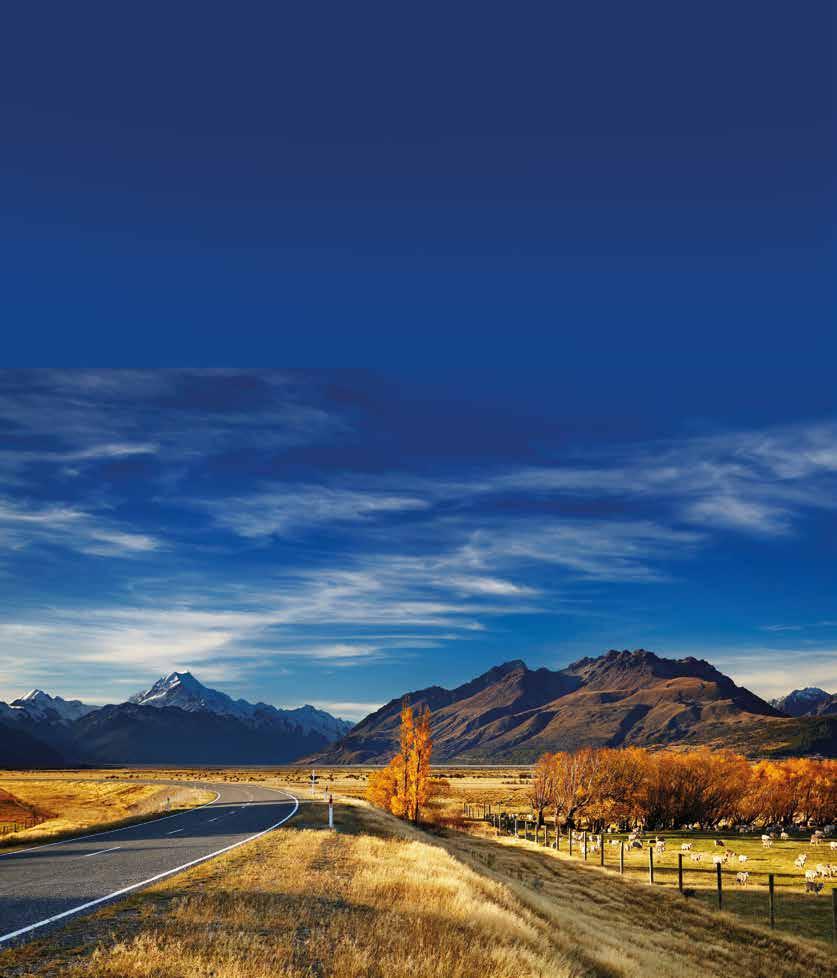


52 Slowing down Time slows on a rail journey to central North Island's Forgotten World.
56 Get Lost!
A quirky game encourages travel with a difference.
66 A remote wonderland Montgomery Reef in Australia's Kimberley region is truly extraordinary.
Jesse Mulligan is a writer, MC and RNZ National radio presenter. He shares his top spot for a nostalgic summer holiday.
“WHEN I WAS A KID, we always used to holiday in the Far North. My grandfather had a place in Whangaroa Harbour, on the east coast. I didn’t recognise how special it was, but as I got older I realised it was one of the most stunning places in New Zealand, if not the world.
The most exciting part of the holiday was opening up cardboard boxes and sliding down the hill on them. We’d hope the grass had dried enough for us to get some speed up.
We’d go to little beaches in the harbour, fishing and collecting cockles and pipis. Sometimes we’d wade out with a net. Real classic Kiwi beach stuff.
The bach was an old Lockwood house with no insulation, big windows, threadbare curtains, but everything you’d want for a magic holiday.”
For the full story, see aadirections.co.nz

Jo Percival takes a road trip from Wellington to Golden Bay.
With each violent gust of wind, my car feels like it might tip over. Clouds sprint across the sun like a time lapse, their shadows creating a strobe effect on the wharf. I am waiting in the queue to board the Interislander ferry with growing unease, watching spray from Wellington Harbour fly in horizontal sheets.
But it turns out that crossing the Cook Strait in gale force winds is a breeze – as long as it is blowing from the north. It is certainly wild out there, but the Kaiarahi takes on the crossing, rising and falling like a giant lung, smooth and rhythmic. The sea whips into white surf peaks and spray flies over the outside decks. Inside, people read and eat and chat, accents and languages from around the world

swirling through the ship. The constant throb of the engines becomes soporific and passengers doze, while the wind wails outside.
From Picton, I pick the scenic route through the top of the South Island. Queen Charlotte Drive is tightly coiled and storm scarred, a narrow, sinuous road winding along the edge of the Marlborough Sounds, through pongafilled bush with glimpses of turquoise bays below. I pull over and walk down to the sea at Governor’s Bay, a thin rind of coarse, golden sand between the sapphire water and jade bush.
On the outskirts of Nelson I deviate from the coast to find Miyazu Japanese Garden. A pocket of zen tranquility, the garden marks the sister city relationship between Nelson and Miyazu in Japan. Fountains trickle serenely. Fragrant wisteria sways in the breeze. A curved red bridge and blue sky is doubled in a still pond.
The heart of Nelson City is its striking cathedral sitting at the top of the granite Cawthron Steps. My visit coincides with the tail end of the Nelson Arts Festival and inside the cathedral I find an installation – Luminary |Luminare – that adds a touch of sublime to the spiritual space. It’s a piece by Auckland artist Karen Sewell, that’s not just visual but multi-sensory, incorporating scents from essential oils, and quiet music. I am soothed from sitting in the stillness, breathing in, breathing out.


On a Saturday morning, the place to be is Nelson Market in the city centre. There’s woodwork and blown glass, textiles and artworks. Bacon sizzles for butties, people queue for pastries and dosas and venison burgers. The sound of coffee grinders mingles with music from buskers. People meander in the sunshine with big, beautiful bunches of peonies and orchids, carrots and kale. It’s like stumbling across the distilled essence of the region’s creative and bohemian spirit. Back on the road, I stop again at the Smoking Barrel in Motueka – a celebration of slow-cooked American barbecue meaty goodness. But that’s not what I’m here for. It also sells the most famous doughnuts in the land. A tantalising array is displayed in a glassfront cabinet – naughty Snickers with bourbon cream, passionfruit and fresh cream, Toblerone cheesecake... I choose a cinnamon dusted, biscoff-cream-filled sugary treat and enjoy every bite.
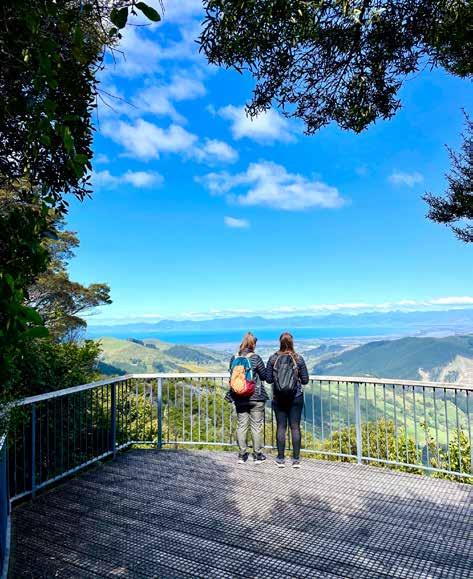
The Tasman District is bountiful land. It seems like the asphalt I’m driving on is the only non-productive strip, sandwiched between orchards and vines in neat rows, as if a comb had been dragged through the landscape. Roadside signs advertise lemons, apples, eggs, walnuts and artworks for sale.
At Kaiteriteri Beach the sand is so golden it’s almost garish. I pad barefoot to the edge of the water; it ripples tantalisingly at my toes, but it’s way too cold for swimming today.
Next up is The Hill; the vast marble mountain that is Tākaka Hill. An earpopping tangle of corners is the only way in to Golden Bay. Not far from the summit I pull over to Hawkes Lookout, walking through water-sculpted marble and beech forest to an expansive vista looking back to Motueka and Nelson.
Golden Bay has been known by many names over the years. Māori have always known it as Mōhua. When Abel Tasman

came along, he referred to the area as ‘Moordenaarsbaai’ or Murderer’s Bay after several of his crew were killed in a battle with the local iwi in 1642. Following the discovery of coal at Tākaka, the bay was named Coal Bay for a while, but was renamed Golden Bay when gold was found near Collingwood in 1857.
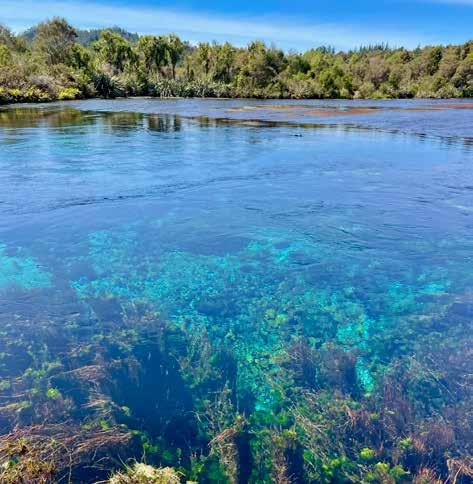
It is an area rich in natural opulence – marble and gold, bordered by the jewel-like ocean, and isolated, being sandwiched between two National Parks – Abel Tasman and Kahurangi.
I arrive at my accommodation, Ratanui Lodge in coastal Pōhara. After several hours on the road, it is a pleasure to sit in the sunshine with a cup of tea while vintage jazz drifts from the nearby dining room.
In the morning, in between Pōhara and Tākaka, I find the network of canyons and crevices that create the ready-made maze known as Labyrinth Rocks. It’s a fascinating spot, but also a bit intimidating if, like me, you make the mistake of not picking up a free map at the entrance.
My heart rate speeds up as the mossy walls of the labyrinth narrow. Passageways separate in multiple directions, leading to other winding paths or dead ends. I realise there’s a very real chance of getting lost here, so begin back-tracking, following my route with relief, back to the car park.
Nearby Te Waikoropupū Springs is wai tapu – a sacred place. It is astonishingly beautiful. The currents from the springs





form whirlpools and eddies, adding texture to the surface of the water as if someone is fingerpainting. The hues are neon blue mixed with the emerald of aquatic plants, clearly visible under the water. A juvenile trout swims lazily just below the surface, or maybe it is metres deep – the water here is some of the clearest in the world; you can see right to the stony bottom. Groups of chatting tourists emerge from the bush track and fall silent, absorbing the wairua of this sacred place, lingering, contemplating.
It’s not compulsory to order mussels at The Mussel Inn, but it would be a bit

rude not to. The historic roadside pub in Onekakā has wide, wooden verandas and a garden courtyard dappled with shade from jungly trees. A fossicking weka stalks around – and on – the tables. My steaming bowl of mussels is plump and plentiful, served with wedges of buttery garlic bread.
Get great discounts on your next road trip, from rental cars to accommodation, at aatraveller.co.nz

The best time to visit Wharariki Beach is at low tide, to get closer to the elephantine islands just off the beach. Today, the surf surges and sloshes around their feet. I feel completely dwarfed by the landscape here compared to the vast expanses of powdery white dunes and soaring islets clad in the beach’s namesake – Wharariki flax.
It’s strange to think that standing here in this iconic spot I’m further north than I was at the starting point of my road trip in Wellington. But my proximity to the aptly named Cape Farewell makes it a fitting point to finish my journey.
On the way to Whangamōmona, a road sign declares in stark black ink: ‘S*** happens quickly.’ It’s meant to deter speeding motorists, but deep in King Country, a place of ghost towns and abandoned rail stops, these words ring heavy with double meaning.
My journey begins at 7am in the grand atrium of Wellington’s train station, at the dawn of a blistering summer day. I join a queue of backpackers, retirees, families wrestling with prams and a handful of cyclists holding onto saddlebagged bikes to board the Northern Explorer bound for Auckland.
The trip is less than an hour by air. By car, sticking to the motorways and state highways, you can do it in a little under eight. In contrast, the Northern Explorer takes 11 hours to snake its way from Wellington to Auckland.
It would be easy to write off train travel as an inefficient way to get from A to B. However, the views that pass by – an expanse of undulating hills, dark tunnels, glittering harbours and awe-inspiring viaducts – makes me think doing so would be missing the point.
After lunch on board, I disembark in the sleepy town of Taumarunui, where I am met by Scott, my host for the evening. On the way, we stop at a lookout for a brief overview of the town's history. Taumarunui’s centre consists of four main streets that once heaved with local commerce, Scott says.
To our right sits the Taumarunui Hospital, once home to a leading orthopaedic unit, now hosting a meagre 10 beds. Centralisation, electrification and the loss of lifeblood key industries such as coal and forestry have taken what was once an epicentre of Kiwi industry from boom to bust.
It’s not all doom and gloom. The Forgotten World region now boasts three canoe companies, granting adventureseekers access to the mighty Whanganui River. Forgotten World Adventures offer tourism packages that include rail carts, jet boats, helicopter rides and fine dining. Recent years have also seen artisans move into the region, setting up flower farms, berry orchards and more.
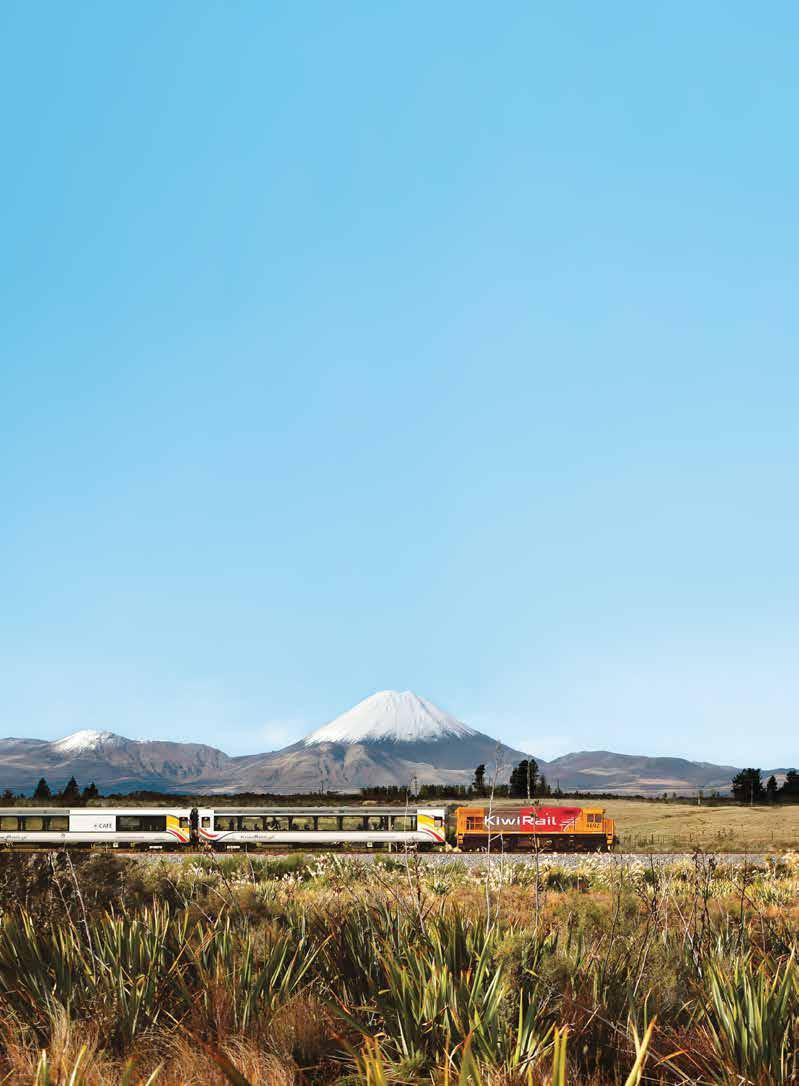
We ascend the driveway of Omaka Lodge past clusters of purple hydrangeas, coming to a cottage with a triangular roof: a visual homage to the mountain peaks behind. I’m greeted with freshly baked lemon shortcake and a friendly sniff from Millie the cocker spaniel. The house is thoughtfully decorated and welcoming, from the art that adorns the walls to the antique grandfather clock. However, the pièce de résistance is the garden: gorgeous English florals sit against a jaw-dropping vista, often used as an altar for boutique weddings. I’m not surprised to learn it’s recently been named a five-star Garden of National Significance.
The following morning, rising rested and ready – as happens when you sleep on a cloud and are waited on hand and foot – I am picked up by Kara of Forgotten World Adventures and shuttled through low fog to the rail line.
The rail carts are a marvel: old golf carts running on 91 unleaded, refurbished to take advantage of the decommissioned stretch of railway line
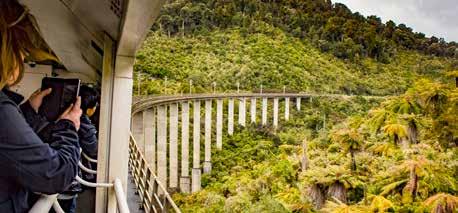

between Taumarunui and Stratford. The steering wheels are just for show; operation is done solely by the push of a pedal. Give it all you’ve got, and you can zip through the countryside on the nylon-covered wheels at maximum speeds of about 22km/h.
The fog begins to lift as we carve our way through hillsides dotted with foxglove and flowering mānuka and I soon realise I’ve been given a gift in my driving companion, Ray.
Ex-milkman, ex-mailman, and lifetime resident of Taumarunui, Ray speaks with reverence about the golden age of the 1950s and ‘60s, when the town population peaked at 7,000 and functioned as the main centre between Auckland and Wellington. Kids across the region used the train to go to school in New Plymouth, and prohibition-era bootleggers would use the line to smuggle illegal crates of alcohol to the gentlemen’s cosmopolitan clubs, or ‘cossie clubs’, Ray tells me. In its heyday, the line saw 10 trains a day – five west, five east, plus a night express train, running native timber and coal out from the region and across the country.

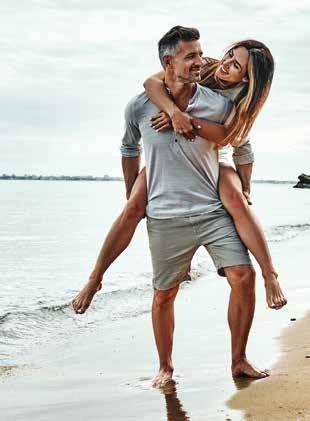

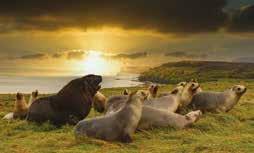

Discover the spectacular UNESCO World Heritage Sites of New Zealand’s remote and wildlife-filled Subantarctic Campbell, Auckland and Snares Islands, the untamed wilderness of Fiordland’s ice-carved mountains, forests and fiords, and Stewart and Ulva Islands on this iconic 12-day Kiwi voyage. Celebrate Christmas in this very special part of remotest New Zealand, observe life at the New Zealand/Hooker’s Sea Lion colony on Enderby Island and wade through waist-deep fields of flowering megaherbs. Share in the magic of the rarely seen albatross ‘gamming’ courting ritual, observe the antics of Snares Crested Penguins navigating the treacherous Penguin Slide and more.
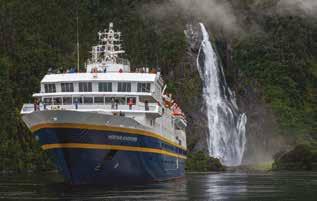





We travel through many of the 24 tunnels – the biggest of any rail lines in New Zealand, built by around 520 men over the course of 30 years. Cool air hits us well before we cross into darkness. The concrete is a foot thick and creates the feeling of entering a large refrigerator, and I understand why my guides forced me to borrow a windbreaker. We stop in the pitch black to learn of the small bays workers would run to when a train approached. The tunnel is higher on one side, creating a faint breeze on our faces in the dark.
We continue on through Matiere, Ōhura, Tokirima, Haeo and Tāngarākau, oncebustling centres, now empty ghost towns home only to the most stalwart holdouts.
We stop for a picnic before venturing on. Occasionally we pass shells of old cars along the trunk line; at one point our journey halts when a stray sheep decides to stroll down the track. I don’t mind the pause.
The entire landscape is magical: beautiful rolling hills, yellow wildflowers, the peak of Mount Ruapehu in the distance, white against clear blue sky.
The trip ends at the historic Whangamōmona Hotel, a truly authentic country pub where the locals greet each other with a raised eyebrow and a grunt before pulling up a stool.
The next morning I bid goodbye to Omaka Lodge and head back into Taumarunui, rejoining the Northern Explorer for the final leg of my journey.
It’s a full train on a hot day, so I make my way to the café for a cool drink



It would be easy to write off train travel as an inefficient way to get from A to B. However, the views that pass by – an expanse of undulating hills, deep tunnels, glittering ocean harbours and awe-inspiring viaducts – makes me think doing so would be missing the point.
before seeking out the open-air carriage where a welcome breeze awaits. As the more dramatic landscape flattens into farmland and townships, I reflect on the past few days.
Travelling by rail forces you to hit pause on the cult of busyness. The train frequently drops out of cellphone range and doesn’t have Wi-Fi; you can’t help but meet other passengers and simply soak in the passing scenery. And after travelling this way, pausing to look out the window and talk to my neighbours, I strangely feel as if I have more time, not less. Perhaps in our full schedules, it’s not just towns and highways we’ve forgotten – perhaps it’s also a way of living. Maybe train travel is one way we can try to remember.
AA Directions has a family pass for two adults and two children travelling in Scenic Class on any of the Great Journeys NZ trains – TranzAlpine, Coastal Pacific or Northern Explorer – to give away.
To be in to win, send your name and contact details to ‘Great Journeys train giveaway’ AA Directions magazine, PO Box 5, Auckland, 1140, or enter at our website aadirections.co.nz by 31 May 2024. T&Cs apply.
AA Members can save 10% on the best available fare on Great Journeys NZ trains. Find out more at aatraveller.co.nz


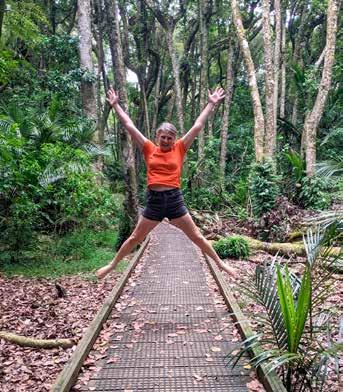

It’s a hot Thursday during the school holidays and with my family at a loose end, I bundle them into the car for an adventure. We head out of town with the music and air conditioning blasting, but unlike everyone else on the road, we don’t know where we are going or what we are going to do. Today’s fun will be directed by a pack of cards and focused on the journey, not the destination.
Getting Lost is a travel game that ditches the predictability of pre-planned itineraries, using ‘misdirection cards’ that instruct players to follow the wind or flip a coin for east or west, and ‘action cards’ for activities to do along the way. While made in New Zealand, the game is designed to be played anywhere in the world and is the perfect way to explore unexpected places off the beaten track.
Once out of the city, we turn over our first card: ‘Follow a blue car’. We soon spy a dark blue ute that becomes our guide. When
it turns left at a roundabout, we do too, cheekily following at a discreet distance as it winds through the rural landscape. After a few twists and turns, the ute pulls into a driveway. We carry on ahead, ready for the next card.
‘Turn Left’ takes us onto an even narrower road. We are now deep in farm country and, as per the game’s objective, are already well and truly lost. When the road abruptly stops, we make a U-turn and consult the next card: ‘Take the first letter of the name of the youngest person in the car and go to the closest town or suburb starting with that letter’. Google shows that the nearest place starting with C (for my son Charlie) is an unfamiliar beach 30km to the west, so we head in that direction.
The road stretches out ahead, lined with hedges and pretty wildflowers, and we curve over dry hills dotted with hay bales and ramshackle barns. The scenery whizzing by is not the stuff of postcards and guidebooks, but it is certainly idyllic. I point

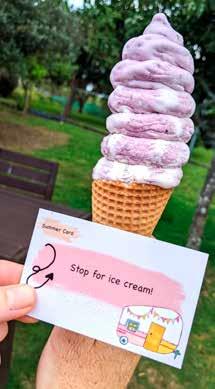
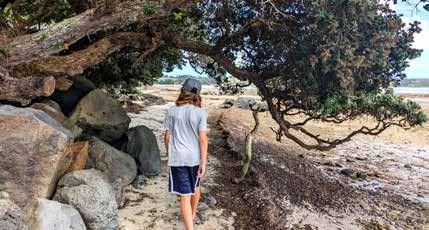
out a weathered scarecrow and an abandoned house covered in graffiti, and my daughter fawns over miniature ponies grazing in a paddock. While we’re not in a hurry to get anywhere, we are pleased to pass the tractor holding up traffic.
Next, we turn over some activity cards: ‘Stop and take a selfie’ and ‘Stop and make a roadside sculpture out of whatever you find’. The selfie is quick and easy but the sculpture requires more time and creativity. Using branches and pieces of wood discarded on a grass verge, we construct a cool tripod structure and decorate it with leaves. It’s good, wholesome fun that has us giggling as we work.
‘Drive to the next signposted natural attraction you see’ takes a while to action, but when we finally spot a sign for a bushwalk, we pull over and oblige. Both kids are fairly reluctant hikers, but as I try to identify the birdsong in the native trees above, they happily take off ahead.
Back in the car, there is a noticeable absence of whining about time and distance, or questioning when we are going to arrive. Instead, there is plenty of hilarity coming from the back seat as the kids put on terrible accents and recount highly embellished stories. My husband names some of the cloud formations we can see and, at one point, there is even a brief sing-along – the true marker of road trip success.

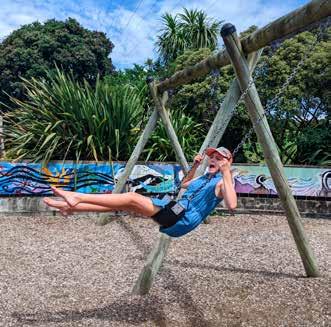
Rounding a corner, we finally catch a glimpse of the sea and head straight for it. There are rocks to be flung, shrieks at the low tide mud squelching between our toes, and while climbing a nearby tree, we are delighted to discover a teddy bears’ tea party set up in the branches. We take the hint and stop for our own little picnic.
After our seaside caper we are instructed to ‘Head North’, coincidentally the direction of the city, and home. ‘Stop for ice cream!’ elicits some happy squeals and we pull in at a roadside veggie shop for some real fruit ice cream. Quiet descends as everyone concentrates on catching the drips running down their cones, and we hit the road again with sticky chins and happy grins.
‘Stop at the first park you see and have a swing’ creates the opportunity for some additional fresh air and play time, and ‘Drive to a house you used to live in’ provides an interesting nostalgia trip for me. Now back in familiar territory, all roads lead home and several hours after setting off into the unknown, we pull into the driveway. Our game of Getting Lost has come to an end. As I shuffle the cards before putting them away, I feel a ripple of excitement not knowing where they will take us the next time we play. Since no two games are ever the same, the possibilities are endless.
gettinglost.co.nz
Percival

Barbara flaps her fleshy wings and, with a sharp-toothed smile, rises out of the water, pressing her writhing body against my legs. But rather than being alarmed by this very (very) close encounter with a wild stingray, I am delighted.
Standing in thigh-deep water off the coast of Tatapouri Bay, dark shadows circle around me. This is the up-close encounter provided by the team at Dive Tatapouri. Here, twice a day at low tide, groups of about 30 people can interact with the wild and playful stingrays that know they’re onto a good thing – coming in from the deep to be hand-fed chunks of fish.

Dressed in one of the most bizarre garments I’ve worn – olive green waders with built-in, clownishly big gumboots – Ben, my husband, Gus, our 14-yearold, and I make our way into the choppy shallows, using bamboo poles for support. Tatapouri Bay is home to around 90 wild stingrays, but only about 20 of them are bold enough to visit the tour groups, our guide Nina explains. They’re all female – having driven any rogue males out of their territory. Barbara is the star of the show – a seven-year-old short-tail stingray who is as friendly as a puppy.
“She loves pats,” Nina says. “Feel free to give her a rub.” I reach into the water and run my hand over her silky, slightly slimy flanks as she wriggles happily in the shallow water.

The sunny afternoon is cooled by a briny breeze. There’s something about the mix of salt spray and sunshine that cultivates a craving for fish and chips or scooped ice cream. We check out Tata Café, part of the camping and glamping precinct at Tatapouri Bay. But rather than classic ice cream, we opt for perfectly made coffee and Best Ugly bagels slathered in avocado and microgreens. Everything tastes delicious accompanied by the tang of sea air.
Later that evening, we dine in the golden sunset glow at Crawford Road Kitchen adjacent to the Gisborne marina. Boats tug gently on their tethers in front of a riverbank lined by palm trees. We tuck into shared plates of delicate fish crudo, crispy fried chicken and salads served in delicious teetering piles.

In the morning we get our bearings at the top of Kaitī Hill. Big turquoise views stretch up and down the coast, the sea enticing in the sunshine. But today we are heading inland to discover one of the East Coast’s hidden gems –Eastwoodhill, the National Arboretum of New Zealand. A tranquil oasis of green, the arboretum is home to the country’s largest collections of exotic trees, with more than 3,500 species cultivated over the last 114 years.
While there are 25 kilometres of walking trails that wind through the gardens, we opt to take a guided tour in a zippy electric golf cart with the arboretum’s expert head horticulturalist, Anthea. She tells us how the arboretum was founded by Douglas Cook in 1910. Cook converted

250 hectares of sheep farm in the Ngātapa Valley, inspired by northern hemisphere gardens he’d visited while recuperating from injuries in WWI.
Today, the arboretum is effectively a botanical ark, with many rare, endangered and nearly extinct species preserved in this little pocket of the East Coast. We learn that northern hemisphere species, like the 81 types of oak at Eastwoodhill, grow three times faster here without the cold winters. We pause in a small grove of Patula pines from Mexico and Anthea encourages us to look up and observe the phenomenon of ‘crown shyness’ – where the trees’ canopies stop a polite distance from each other.
Just up the winding country road from the arboretum is the famous Rere rock slide. We’d planned for this, bringing

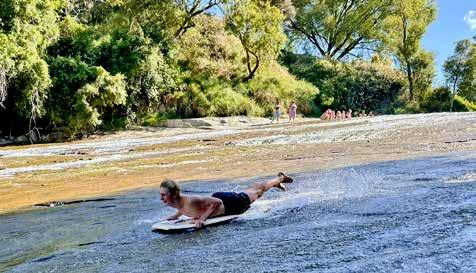
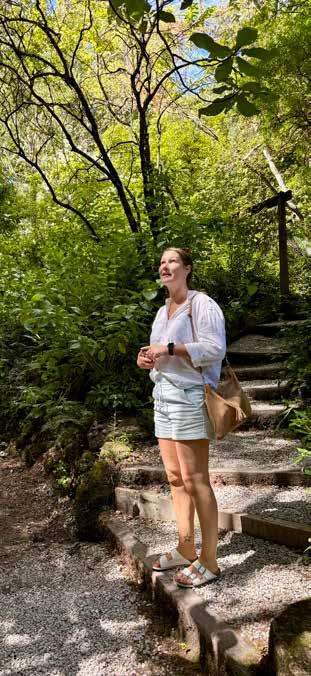
boogie boards and wetsuits from home, though my anticipation is mixed with a large dose of nerves. Not least due to the stretch of aggressively slippery rocks to navigate at the top of the falls.
I inch my way to the edge of the slide like an ungraceful, neoprene-clad seal, teeth gritted and then the current catches me and I’m off – faster and faster, juddering over outcrops, spray flying, until I skim and splash into the pool at the bottom. Exhilarated. And slightly battered.


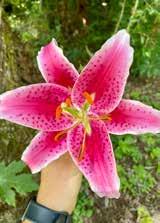
Teenage Gus is in his element, picking the fastest routes down the slick rock face and learning where to position his weight to get maximum skimming distance at the bottom. I’m quite content to spectate after my sole run. No need to invite a middle-aged injury.
Back at the coast, we take stock of our day’s adventures at the newly opened Tahu – a stylish restaurant maximising its oceanfront position on the Waikanae Beach surf club balcony. Happy diners soak in the salty sunset while the waves froth down below.
It would be remiss to visit Gisborne and not experience the famous surf. So, on our last morning we meet Holly Quinn (sister of world-champion surfer, Maz) from Salt Shack Surf School for a lesson. Lying on the sand Holly shows us how to wax our boards, how to paddle and how to pop up, though I soon learn that transitioning from a prone position to a crouch on a moving surfboard is much easier said than done. Gus, of course, nails it – leaping to his feet with the spring of youth. I’m content to stick with kneeling, curving my board through the whitewash.
Salty, sandy and satisfied, we peel off our wetsuits and settle in contentedly for the drive home.
Be in to win a Gisborne getaway for two with AA Directions including a two-night stay at Tatapouri Bay Accommodation, a Dive Tatapouri stingray experience, a Gisborne Railbike Adventure and a $50 voucher to spend at Matawhero vineyard.
To enter, send your name and contact details to ‘Gisborne escape giveaway’ AA Directions magazine, PO Box 5, Auckland, 1140, or enter at our website aadirections.co.nz by 31 May 2024. T&Cs apply.


Elisabeth Easther and son Theo enjoy quality time in the Kingdom of Tonga.
The Kingdom of Tonga has had a hard time of it recently, from the pandemic that closed the borders for nearly two years to the violent undersea volcano that erupted in January 2022, causing untold damage. This is partly why my son Theo and I chose to visit; we wanted to support Tonga’s tourism industry as it got back on its feet. There was also a less altruistic reason – we’d always dreamed of swimming with humpback whales.
After a handful of days on the main island of Tongatapu we headed for the Ha’apai group of islands, 129 kilometres north of Nuku’alofa.
From the moment we entered the domestic terminal, our outer island adventure began. The departure lounge was little more than a handful of chairs. With no café or refreshments on offer and two hours to kill, we wished we’d bought provisions.
Onboard our 15-seat plane, we were impressed to see a woman carrying an enormous cake. The iced work of art looked dangerously precarious perched on her lap, but she must have been used to transporting ornate baked goods as it survived the trip.
Once airborne, our attention turned to the azure ocean below. Dotted with unspoiled, uninhabited islands, tan sands fringed with coconut palms, it was like a postcard come to life. Theo, with his younger, sharper eyes, even spied whales.
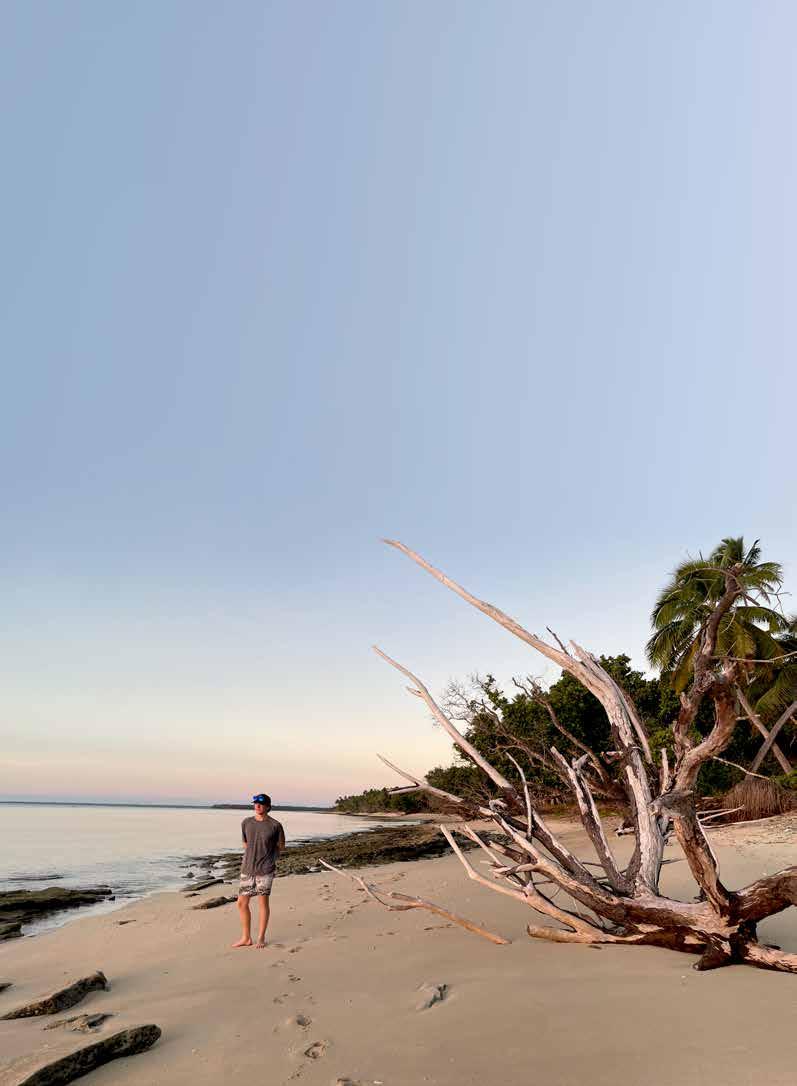
Having landed on Lifuka Island, one of 51 in the Ha’apai group, a boat whisked us to Uoleva Island, the home of Kitesurf Tonga. This sublime off-grid hideaway was built by kitesurfing couple Glen and Karen Duncan. As soon as our bare feet met the soft sand, we knew we’d been wise to go that extra mile. Without pause, we settled into island life. Our fale, simultaneously rustic and refined, was one of just five right on the beachfront. Beds with mosquito nets and solar-powered lighting kept us comfortable, and the big bamboo-lined bathroom was charming. Meals were a thrice daily treat – culinary wonders whipped up by ex-pat Kiwi Jeremy, served at one convivial table. Much of the produce was grown onsite by Glen, while Karen garnered respect with her baking.
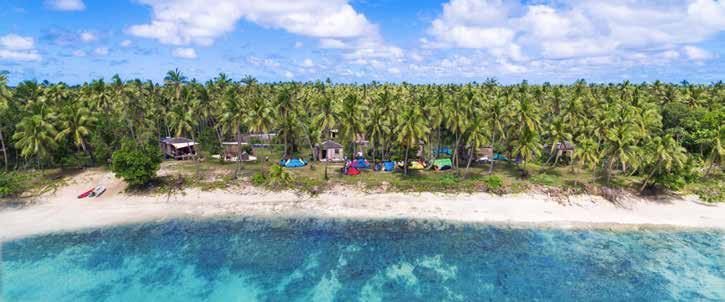
Waking on our first morning, the weather was deemed ideal for whale watching so it was all aboard Glen’s 8.5m vessel Tropic Bird. Of course, whales can’t be guaranteed; nature doesn’t make appointments.
But we were in luck! Seeing humpbacks in the wild was as magical as we’d dreamed. Searching for their vast bulks just a few hundred metres from shore, I was struck by the contrast between our joy in spotting these precious creatures and the motivation of whalers past. As we scanned the horizon, pointing and exclaiming when we thought we saw a spout, a fluke or a tail, time stood still.
My heart ached to picture those mariners who’d come before us, armed not with snorkel gear and goodwill, but harpoons. As I gazed in awe at mothers with their calves, I marvelled at their majesty and silently apologised to their ancestors.
We enjoyed two ideal days of whale watching and, when the wind blew, our fellow guests headed to the tip of the island for kitesurfing while Theo and I explored. Other times, we snorkelled on the reef right on our doorstep, where crystal blue water teemed with aquatic intrigue.
On day four we motored back to Lifuka Island for Agricultural Day, an impressive annual event we were fortunate to witness. In honour of this celebration of abundance, the island’s dusty streets





were lined with cabbages as big as bowling balls. Our arrival at the local sports ground coincided with King Tupou VI and Queen Nanasipau’u Tuku’aho on a royal walkabout. Accompanied by a sizable entourage, the regal party trod on paths of woven mats, the island equivalent of red carpet. Stopping at various stalls to admire plants and produce, artwork and edibles, the nobles were full of praise for the long avenue of tables groaning with fish of all species, everything from sharks to rays, stonefish to marble fish, even a Napoleon wrasse.
While we found the sheer mass of fish confronting, we also understood the need to celebrate following the privations of the pandemic and the eruption. We had heard many horror stories from those bleak times. The sonic booms, the towering plumes of ash, the sun so dimmed that terror struck the heart of every living creature. On the main island, as panicked people drove to higher ground to avoid the tsunami, windscreens and headlights became coated with thick layers of ash. There were countless collisions, with drivers unable to see more than a few inches ahead on the road.
Today though, The Kingdom of Tonga is back on track. We came home recommending to anyone who would listen that they book flights, pack masks, snorkels and fins – and time a visit to Tonga between June and October to increase the chance of seeing humpback whales on their annual migration. For us, the experience of doing so, in such an idyllic place, was a dream come true.



Brett Atkinson explores Australia’s remote Kimberley region.
When Sir David Attenborough describes a unique part of Western Australia as 'one of the greatest natural wonders of the world', it pays to listen up.
Sir David was talking about the Kimberley's Montgomery Reef, stretching for 400 square kilometres along Australia's remote northwest coast, visited by the iconic nonagenarian in 2008.
We're experiencing the Kimberley's amazing natural phenomenon, first in one of the True North's purpose-
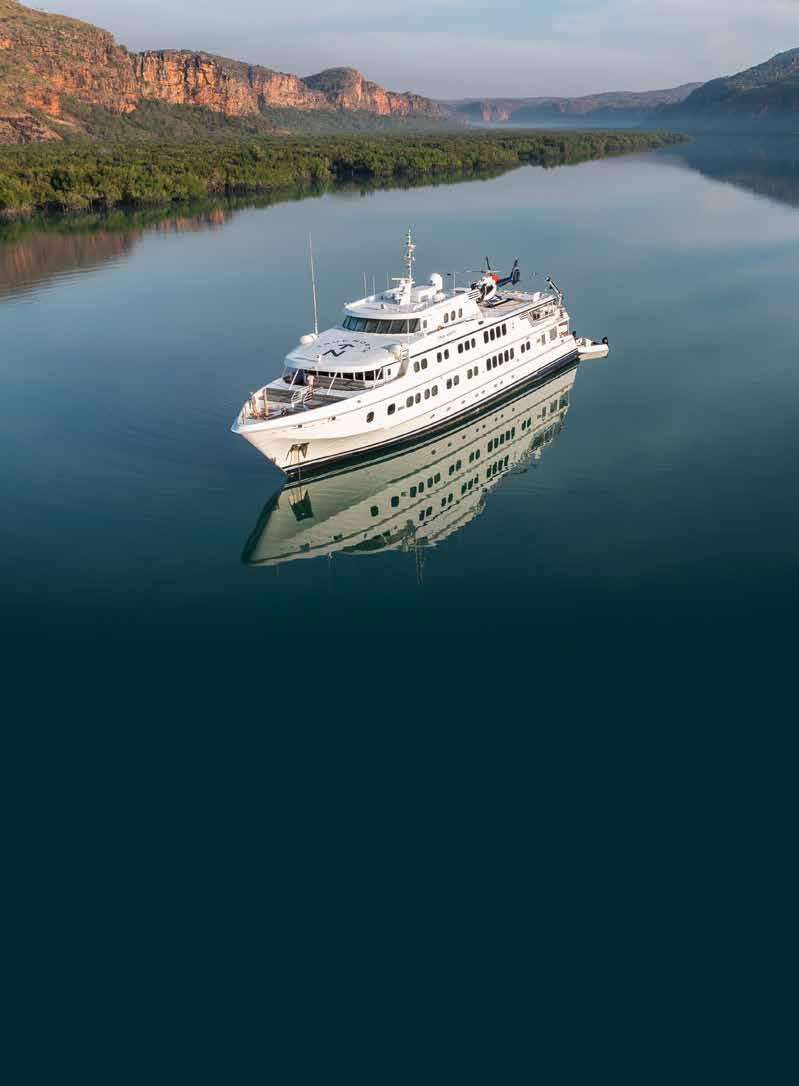
built 'adventure boats,' and then in a spectacular helicopter flight departing from the stern of the luxury vessel.
Over just a few hours, the southern hemisphere's biggest and most rapid tidal movement has taken place, transforming a marine-scape inhabited by sea turtles and manta rays, and causing an ocean maelstrom to surge across the reef's indigo-coloured coral. High above in the True North's chopper, horizontal cascades score the reef's meandering profile, and pilot Rob Colbert is pointing out sharks and
dugongs basking in the sun-warmed waters below us.
Two days earlier we'd first boarded the True North, wading through the shallows of Broome's Cable Beach to motor out to the boat for a first night greeting combining seared scallops, bubbles from Margaret River wine country and a sublime West Coast sunset. Fast forward around twelve hours, and waking up to a Kimberley sunrise has revealed cobalt waters and a remote red-earth landscape as we contiue on a week-long journey north from Broome to the remote

port town of Wyndham, exploring the natural highlights of a region regarded as Australia's greatest wilderness area.
Life on board the 50m expedition boat soon assumes its own compelling rhythm. Rise early for another spectacular Kimberley dawn, with the sun ascending over a leviathan and labyrinthine coastline, before breakfast in the dining room with the boat's maximum tally of 36 guests. Morning departures in the True North's adventure boats, helmed by a youthful crew blending authentic Aussie
charm with a savvy understanding of the region's natural heritage, could involve bird-spotting up a river system, or taking in the quintessential Kimberley combo of crocodiles cruising past the boats' gunwales, and rock wallabies ascending like snakes and ladders up vertical 1.8 billion-years- old sandstone cliffs. Back to the cruise ship for lunch – often featuring Western Australian ingredients – before loading up the adventure boats for another on-the-water experience, maybe fishing for barramundi or casting baited

mud crab pots deep into the mangrove maze of the Hunter River. Cocktails and canapés usually kick off on the back deck around 5pm, before the day once again dissolves into one of the planet's finest sunsets. And because shoes aren't allowed to be worn on board, another relaxing constant on the True North is padding about on the vessel's teak decks in bare feet.
Heading north from Broome to Wyndham, occasionally diverting to the surprisingly calm waters of the northern Indian Ocean and Timor Sea, most of the True North's time during the day is spent in sheltered anchorages and arcing bays. It's a big sky and even bigger horizon, the seascape providing spectacular background scenery to experiences even more exciting than a morning or afternoon excursion in the adventure boats.
Deep within the island-studded Buccaneer Archipelago, the calm and sheltered waters of Talbot Bay are ambushed by another natural phenomenon unique to the Kimberley. Visiting the bay just two days after a full moon, Talbot Bay is currently experiencing huge – and rapid – tidal shifts of almost ten metres.


Designed to explore the rivers and canyons of the Kimberley, the True North is uniquely able to access remote parts of the
We'd previously heard True North's onboard naturalist and backup skipper Chris Mirbach explain: “In the Kimberley, the tides rule what we do,” and now, waiting to go through the famed Horizontal Falls, he's as much in awe of the afternoon's impending adventure as we are.
Caused by a shallow continental shelf extending into the Indian Ocean, Talbot Bay's massive tidal movement is squeezed through a brace of natural chasms linking otherwise flat sections of water. Waiting for our turn, we watch other True North crew and passengers speed through the rocky outcrops as thousands of litres
of water surge inexorably through the narrow gap. Upon entering the chasm, it's a rollicking few seconds riding the improbable peaks and troughs of the Kimberley's greatest natural thrill ride, before exiting to a benign lagoon and then circling around to do it again. Beyond adventure boat experiences, we also venture inland away from the Kimberley's rugged coastline. Pilot Rob negotiates a thrilling 20-minute helicopter flight up the Sale River, criss-crossing above the river's gorge, before finally flying down a terracotta canyon to land just metres from a remote waterfall and swimming hole. Another secluded spot
only reached by helicopter is Eagle Falls, named by the True North team on an earlier visit, and now an isolated location for a barbecue and a relaxing afternoon of swimming. On a cooler Kimberly August morning, a short beach walk leads to Vansittart Bay's indigenous rock art, a highlight of an area traditionally owned by the Wunambal Gaambera people. Protected by caves and sandstone overhangs, indigenous art works dating back tens of thousands of years still glow with creativity and spirituality.
Designed to explore the rivers and canyons of the Kimberley, the True North is uniquely able to access remote parts of the region. With a shallow draft of just 1.2 metres, skipper 'Gav' Graham steers the boat through a narrow gap in the Prince Regent River and edges the bow up to the multi-tiered Kings Cascade. From October to March during the Kimberley's wet season, both rain and humidity peak, and the cascade's rocky terrace is awash with teeming waterfalls. An August dry season visit is more subdued, and after an impromptu natural shower while sitting on the bow, we embark on a 30-minute bush walk, first scrambling up and over scrubby boulders, before negotiating a rope down to a swimming hole. A short rocky hike inland reveals more swimming holes concealed in Kings Cascades' one billion-year-old granite and sandstone landscape.
Our final day onboard is spent exploring the King George River, journeying by adventure boat for 20 kilometres up a narrow waterway framed by sandstone cliffs stacked haphazardly like a giant game of Jenga. The river's tightly arrayed canyons are scarred with the mossy blackening of wet season waterfalls, but under perfect late August skies, just a few gentle trickles hint at the natural power that will soon emerge to reinvigorate the Kimberley's seasonal cascades.
The True North explores the Kimberley during the region’s dry season, from mid-March to August. From September to mid-March, the company embarks on other cruises around coastal Australia, Papua New Guinea, West Papua and the remote Raja Ampat archipelago. See truenorth.com.au



Sharon Stephenson visits an unusual home with a fishy history.
"WHAT SHOULD WE DO with our fish factory?" It’s not a question many of us will ever have to ask. But then most of us don’t plunge our life savings into a two-storey warehouse with a distinctly fishy aroma.
The late Paul Larkman, however, found himself in that position in 2017 when he bought a run-down commercial building in the Lower Hutt suburb of Petone.
“Dad grew up in the area and although he moved to Paeroa where he owned a pet-food company, he always wanted to return to Petone,” his daughter Polly Larkman says.
The building was built in 1939, initially as a dry ice factory, before being converted into a fish processing and wholesale market. It wasn’t in a good way when Paul bought it, but he could see its potential as a loft-style apartment for himself and his wife.
Sadly, Paul passed away a month into the build. At the time, Polly was living in London with her now husband, accountant Antony D’Esposito. She decided to fulfil her father’s dream and moved back to New Zealand to oversee the renovation.
It helped that Polly works as a commercial asset manager so had her finger on the property market pulse. Having a strong design ethic didn’t hurt either.
“The aim was to keep a sense of the building’s heritage but to also turn it into a stylish, comfortable home,” Polly says.
But before any hammers could be swung, years of fishing detritus, including old nets and crab baskets, had to be removed.
Designed by Wellington architect John Mills, the year-long build involved gutting the space and extending it by 20sqm –increasing the building’s footprint to 170sqm. That created a contemporary living room which leads onto a deck that Polly has landscaped into various zones.
The star of this space is a suspended rotating fireplace, which can serve as both an indoor fire and outdoor heater.
The couple knocked out a wall to open up the kitchen and dining area which is accessed via a few steps. This space was previously used as the fish factory’s shop and the large tin sign which hangs on one wall came from the original shop. “It’s a nice connection to the building’s history.”


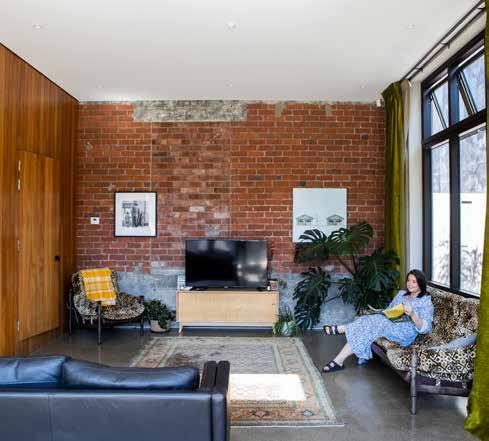

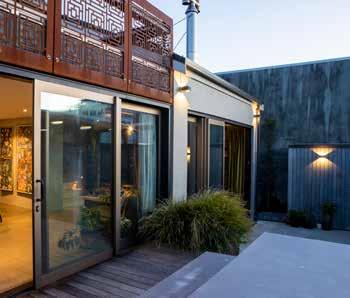
Another artwork with special significance is the large colourful dogroll advertising sign by renowned Kiwi artist Dick Frizzell, a nod to the pet food company Polly's father once owned.
Both Polly and her husband love to cook, so a spacious kitchen was top of their wish list. “We’d lived in tiny English flats for so long that we really wanted lots of space to cook and entertain friends.”
A must-have was the 3.2m long granite worktop which was constructed as one piece and took several burly builders to manoeuvre into place.
Upstairs are two bedrooms, including a guest bedroom which doubles as a study, and the main bedroom which is flooded with light from the floor-to-ceiling windows.
A metal screen not only aligns with the building’s industrial bones, it adds privacy to the generous deck which extends from the main bedroom.

We’d lived in tiny English flats for so long that we really wanted lots of space to cook and entertain
friends.
Privacy is, in fact, a key part of this luxury conversion. The house itself lies off a busy thoroughfare, tucked between a supermarket and a fast-food store.
“Most people have no idea that there’s even a house here,” Polly says of the location, which is mostly home to industrial and retail sites. “First-time visitors often get lost.”
Access is via a side entrance and a ‘forest’ of black lancewood trees which creates a suitably dramatic introduction to the property. Double glazing blocks
out the surrounding neighbourhood noise, further adding to the home’s urban sanctuary feel. Skylights were added to bring light into the space, including the downstairs living room where it bounces off a wall of eucalyptus planks that Paul had found years ago and saved for the right occasion.
It’s been four years since the couple moved in and they say the house works perfectly for them.
“I’m so pleased Dad had the vision to turn an old fish factory into such a cool home which is easy to live in, keep clean and style,” Polly says. “The industrial feel means that it suits a lot of vintage and op-shop furniture and we’re a few minutes from the beach, which is handy to walk our dog. The area has also changed since we’ve been here, with more bars and cafés. We definitely don’t see ourselves leaving any time soon.”
Sort jobs around the the house with AA Home Book a Job. Do you have a dripping tap, new purchases to be assembled, an aircon or heat pump unit that needs servicing or a hole in your fence? To find out if AA Home Book a Job services are available in your area and to book an AA-trusted trade professional, go online to aahome.co.nz
Vanessa Trethewey investigates the Simplicity scheme that’s shaking up New Zealand’s housing sector.
NEW ZEALAND’S OBSESSION with real estate shows no signs of waning, but for many of us the Kiwi dream of home ownership (or even just having a warm, dry place to live) is rapidly disappearing.
Luckily, former financial highflier Sam Stubbs is in our corner. Not only does he reckon “it doesn’t have to be that way,” but the company he helps run is on a mission to shake up the finance and housing sectors, with a goal of funding and building 25,000 new homes across Aotearoa in the next ten years.
A self-proclaimed ‘gamekeeper turned poacher,’ Sam and his equally passionate sidekicks Amanda Morrall, Andrew Lance and Amir Bashir founded Simplicity KiwiSaver seven-and-ahalf years ago, a non-profit default KiwiSaver provider hellbent on creating a better world for all New Zealanders. Now boasting 150,000 members and managing $5.8 billion, the fund has rewarded investors well and also donated $7.3 million to charity. But according to Sam “this is just the beginning.”
Now Simplicity has set its sights on addressing the housing crisis, taking a
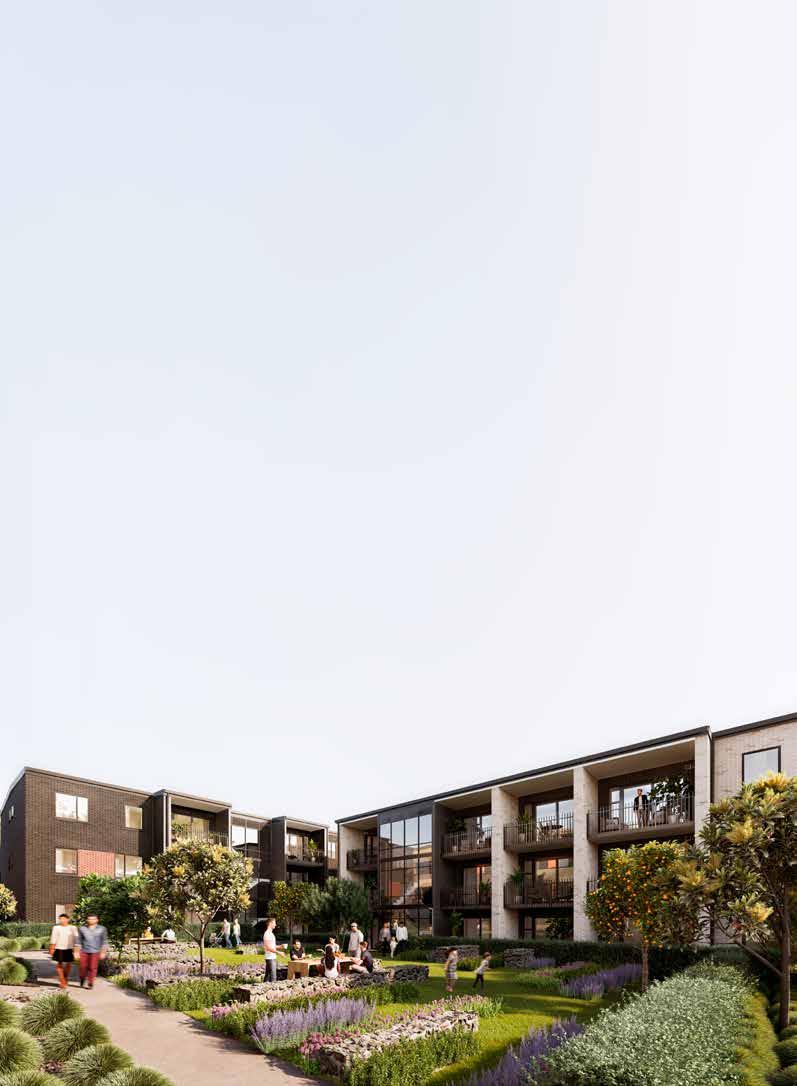
three-pronged approach which includes offering 10,000 lower-cost first home mortgages, funding 5,000 community homes, and rolling out a build-to-rent scheme through Simplicity Living which aims to provide 10,000 quality properties for long-term renters – while also providing investors competitive returns.
Already Simplicity has invested more than $340 million in residential housingaligned investments, with well over 1,500 rental homes completed, funded or in development through Simplicity Living and community housing providers, and almost 300 low cost first home mortgages.
Recently though, it’s upped the ante with the launch of a new Homes and Income Investment Fund that aims to considerably boost Aotearoa’s housing supply.
“We want to move the needle on housing supply because right now it’s out of kilter,” Sam says. “The Simplicity Foundation gives away millions of dollars a year, but that’s funding ambulances at the bottom of the cliff; the fence at the top of the cliff is having warm, dry houses.”
Sam believes the root cause of many of New Zealand’s problems is that we don’t have enough houses to accommodate people, and he’s making it his life’s work to help fix the issue.
“We’ve been working towards this for a few years but now we’re really thinking big,” he adds.
Why now?
“I had a lightbulb moment – well, two actually. I met a Pasifika family who were renting and in nine years, they’d had to move eight times and their kids had moved schools five times. Then one day my daughter came home from her decile ten state school and told me that two of her teachers were living in garages. I thought, ‘what’s going on here, this is not the New Zealand we want’.”
The Homes and Income Investment Fund will certainly help dial up Simplicity’s ability to “make money and do good,” and the more Kiwis that get behind it, the faster it will reach its target.
“We already have hundreds of millions of dollars invested in housing, but we want it to be billions. If Kiwis invested 5% of their savings with us, we could increase New Zealand’s housing stock by 25,000 homes. We can’t solve this problem overnight or by ourselves, and it will take decades to fix the problem, but our aim is to make a significant difference to housing in New Zealand.”
The Simplicity Living build-to-rent scheme is already gaining traction with three developments (two in Auckland’s Point England and another in Onehunga) now completed and fully leased, and a development in Mount Albert due for completion in a year's time. Another three larger Auckland developments are in the pipeline – 297 homes in Mount Wellington, 320 homes on the Ellerslie Racecourse, and a recently announced development in Morningside providing a further 230 homes.
Warm, dry and “built to last for 100+ years” – over twice the lifespan promised under our current Building Code – the new apartments are all being built to Homestar 7 standards, are located next to major transport and amenity hubs, are at attractive rents, and offer long-term security for renters.
“We want to become one of the biggest suppliers of long-term accommodation in New Zealand. And because all of our developments are very similar in design and build, we have huge economies of
scale with building costs typically 35% below market. These savings can then be passed on both to our tenants and our investors. In our current developments, apartments are on average 2.2 bedrooms, 15% larger than typical apartments, and we build them for about $550,000 turnkey. Moving forward we’re looking to build them 8% bigger again. Why? Because we want to build homes people want to live in, homes that if they choose to, they can rent for the rest of their lives.”
BCO10333249-2 Received by Auckland Council 17/08/2021
The impact that reliable housing has on people’s lives and mental health is dramatic, and being able to say the magic words ‘you’re safe’ to someone is incredibly powerful.
Greenspace is a top priority, occupying a third of each development (“we typically plant 60 plants per apartment”) and construction is offset through native tree planting. For every apartment rented, Simplicity Living funds the planting of a tree every week via the charity Trees That Count.
The long-term security Simplicity Living offers tenants is a relatively new concept here in New Zealand, but as Sam points out, lifelong tenancies are the norm in many other countries.
“We don’t like investing too much in new ideas – we like investing in ideas that have worked overseas. Around 42% of people in the OECD live in apartments and the majority of those are renting. In New Zealand it’s more like 4%, so we have a long way to go, but if people can reliably rent long-term, many might well choose that.”
Through Simplicity, Sam is offering a win-win – both for Kiwis needing homes and for those keen to build their wealth while creating a better New Zealand.
“We buy the land, develop the properties, rent them and manage them ourselves which not only cuts out a filo pastry of fees, but also means we’re heavily invested in our tenants and the community experience. We can give parents security that their kids can stay at the same school, and elderly peace of mind that they’ve got somewhere to live for life. The impact that reliable housing has on people’s lives and mental health is dramatic, and being able to say the magic words ‘you’re safe’ to someone is incredibly powerful.”
As far as Sam is concerned, having a warm, dry home that you can call your own – whether you own it or not – is the ultimate fence at the top of the cliff, and he couldn’t be prouder to be a driving force behind reshaping New Zealand’s housing landscape.
“This has ended up being much more of an emotional journey than I expected. I feel very lucky – I have the best job in the world.”

One of just two weaving mills left in New Zealand, Masterweave Textiles in Wairarapa creates luxurious blankets, throws and scarves out of natural fibres.




IT ALL BEGAN more than 35 years ago when Lindsay Cairns, a Wairarapa goat farmer came across a defunct textile mill in the heart of Masterton. What started as a small off-farm interest soon became Lindsay and wife Philippa’s new career as they learned the ropes of weaving.
“As a farmer, I was frustrated that there weren't more New Zealand-made products using Kiwi wool or mohair,” Lindsay says. “That was what started my interest.
“Because I had a farming background I picked up the necessary skills fairly quickly. I’m just a practical Kiwi bloke!” he laughs.
Originally the bulk of Masterweave's business was making traditional woollen rugs. “In the 1960s and 70s everyone had a travel rug in the back of their car,” Lindsay says. “Woollen rugs were still a big market in the late 80s and initially we sold thousands of those. But that fell away with the increase in Chinese imports and people’s bedding preferences changing to duvets. So, we shifted into boutique products using mohair, alpaca, and now our boucle wool.”
Today, Masterweave has a team of eight staff working in the completely solar-powered Masterton factory.
“When people think of textile mills, they think of big factories with hundreds of people. But those days are gone, for New Zealand, anyway. We are bigger than a craft mill, but we’re certainly not in the big league!” Lindsay says.
The company produces around 20,000 mohair and alpaca throws and between 12-15,000 merino scarves each year. “About a third of our stock is exported, mostly to Australia but also the US and Europe, and a third goes to the tourist industry in New Zealand – tourists love locally-made, Kiwi products. The rest is sold via homeware or department stores.”
Not only does Masterweave supply bespoke blankets and throws for luxury lodges like Millbrook and Huka Lodge, the company was also responsible for crafting a lot of the textiles used in the costumes for The Lord of the Rings.
“We did most of the large-scale weaving for the films. That meant we had one machine weaving for six months just on The Lord of the Rings,” Lindsay says. “Everything had to be made in two different scales, of course. When a hobbit has a blanket and

hands it to Gandalf, it was made in two different sizes, and both had to drape and flow in the same way.”
As a former farmer himself, Lindsay says he is glad to be supporting the local textile industry and the farmers who produce it. “New Zealand mohair is our main line. Before we started using it, you could only really get South African mohair throws in New Zealand. So I’m proud that we’ve brought New Zealand mohair to the local market. We source mohair mostly from the South Island and we probably take the majority of that fibre grown in New Zealand to use for our blankets and throws.”
AA Directions has one luxurious Masterweave mohair throw (RRP $299) to give away. The lucky winner can select their throw from the Masterweave range.
To be in to win, send your name and contact details to ‘Masterweave mohair throw giveaway’ AA Directions magazine, PO Box 5, Auckland, 1140, or enter at our website aadirections.co.nz by 31 May 2024.
How to increase your money smarts, by Vanessa Trethewey.
AS THE COST OF LIVING CRISIS continues to bite, getting on top of your finances can feel a bit like wading through treacle.
According to research commissioned by Te Ara Ahunga Ora Retirement Commission, over half of Kiwis are feeling financially squeezed. The Commission’s 2023 annual survey revealed 51% either ‘starting to sink’ or ‘treading water’. Feeling the pinch impacts all aspects of daily life and can have significant longterm consequences, reducing our ability to set ourselves up for the future.
But there’s good news, too. With a strong desire to create positive change – and the right support – budgeting, tackling debt, and getting ahead is still possible, even in these tight economic times. A wide range of excellent free budgeting services are available online and nationwide, and there are companies like enable.me which help people get back in the driver’s seat of money management. Yes, you pay for the privilege, but it’s a formula that works.
In the 15 years since Hannah McQueen launched enable.me she has helped thousands of Kiwis build their wealth. The business now has 90 staff, offices in six locations, and has recently merged with Advice First with plans to launch into Australia.
“We are in the business of changing lives,” explains Hannah. “Our clients range from those in their early 20s to their early 80s. Some have lots of money, some have very little, some are good with money, some are not; some own property, some don’t. But the one trait they all share is that they want to do better than they’re currently doing.”
The demographic is wide but it’s the 45 – 55 year olds who make up the bulk of their market.
“These are the clients that want to pay off their mortgages, make wealth moves, ensure their children become financially independent, and retire comfortably, maybe even early.”
Sound like a dream? Hannah reckons it’s not as difficult as you might imagine.
“A lot of the people we work with earn a good income, they’re just not making the progress their income says they should. Many are financially literate but they don’t have a plan, don’t know how to make big wealth moves and are inefficient with money management. Some people need to be smarter with their money, some need to get their money to work harder for them, but for most people it’s both.”
Each enable.me client is matched with a financial advisor and coach.
“Most people work with us for 12 months at a time. In that first year we try and move a mountain, solving as much as we can so it’s easier to make progress. We help people accelerate the speed they’re moving forward; if someone comes to us hoping to get on the property ladder in five years, we aim to get them there in 18 months. We have methodologies and guard rails designed to keep clients engaged, make it as painless as possible and see progress as quickly as possible. That’s the magic formula.”
But while expert advice and guidance is worth its weight in gold, there’s also much to be gained from talking to others who are treading the same path, as MoneyMates practitioner Alyson
de Marco explains. “Sharing your experiences about money is so valuable. Parents don’t tend to do it with their children but it’s probably one of the cheapest and best things they could do.”
Manager of Auckland’s Tamaki Budgeting, Alyson is known as the ‘MoneyMates guru’ and is deeply passionate about the nationwide MoneyMates initiative which offers support groupstyle weekly meetups at neighbourhood community centres and cafes.
“I’d say there would be around 80 services in the country that are successfully running MoneyMates meetings, but I think that figure will double for 2024 because more facilitators are going into training, more people are becoming aware of the service and people can see how exciting it is.”
Each week different topics are discussed, from goal setting, compounding interest and how much money is enough, through to tips for reducing the grocery bill, and managing the cost of funerals.
“We had one recent meetup discussing wills and enduring power of attorney. So many turned up some had to sit outside.”
Helping people boost their financial capabilities gets Alyson out of bed every morning. The best part? “Seeing people achieve their goals as a result of coming to MoneyMates. We’ve had a solo mum on a benefit who is now a homeowner, we have people on their third cruise, and a couple who have both gained master’s degrees. We encourage people to dream big; give us ten compelling reasons why you really want something, and we can show you how.”
Waikato-based farmer and vet Emma Poole made history as the first woman to win Young Farmer of the Year in 2023. She and her husband milk 1,000 cows across two farms in Pirongia.
How did you get into farming?
Mum and Dad are farmers and my dad’s parents were farmers, so I have been surrounded by it my entire life. When I went to university, I met my husband Chris who had a similar upbringing to me.
Do you find it rewarding?
Farming is a job where you get to live and breathe your progress. Every time you improve something on farm you get to reap the benefit of that the next day; that continual improvement is very rewarding.
Do you need to be good at business to be a successful farmer? Not necessarily, although a strong sense of business will help. Most people who are attracted to the industry are not doing it because they are experts at running a business; they are drawn here because they love animals, the land or machinery. The business skills tend to develop as you go.
What did becoming New Zealand’s Young Farmer of the Year in 2023 teach you?
If you are part of a good community they will rally around and support you. If you spend time giving back to the community, that support will grow.
Does money matter to you?
I like to keep things simple and most of the things that make me happy are actually free. Yes, money matters so that I can look after my family and provide my kids with future opportunities, but I don’t let it dictate my life and happiness.
How would you describe your relationship with money – are you a saver or a spender?
I get a haircut only about once a year and replace a few items of clothing every few years, so my maintenance costs are low But I do spend money on DIY projects involving the house. I absolutely love building, it’s a real hobby of mine.
Did anyone teach you about money?
I always had a pretty good sense of what it was worth growing up because Mum and Dad were such hard workers. They worked tirelessly to give us kids a better life and a whole raft of opportunities growing up. We never had flash things or went

on extravagant holidays, but we always had everything we needed. It was more of a ‘show than tell’ life lesson from my parents and I am so grateful because a good work ethic is one of the greatest gifts they could have given me.
What money-related advice would you give your children? Being on a farm, we are lucky that there is always work to do and ample opportunity for the kids to make some pocket money. They could rear a few calves, or do a milking or two. If they earn the money themselves, they will appreciate it a lot more than if I just gave it to them.





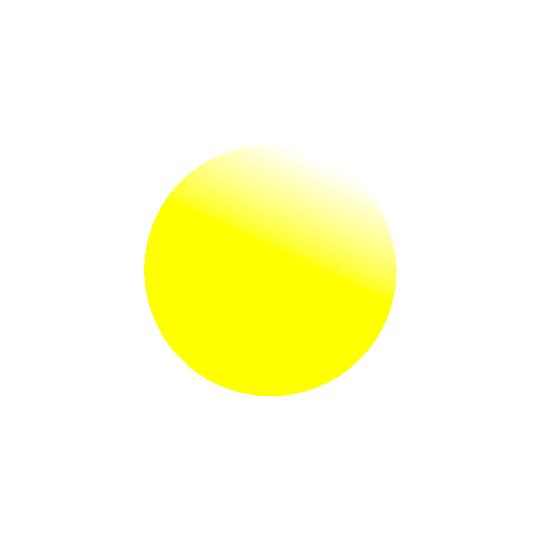










Today, Dani’s role as a compliance inspector sees her analysing vehicles that have recently arrived in the country to ensure they meet New Zealand’s safety standards.
“Most of our cars come from dealers,” Dani explains. “They purchase the vehicles overseas, have them shipped to their yards and then they bring them to us to make sure they’re compliant before they can be registered and sold.
Daniela Salzmann works as a vehicle compliance inspector at the AA’s Vehicle Inspection Centre in Napier.
A QUALIFIED MECHANIC, Dani has been with the AA for nine years, after emigrating from Switzerland in 2005.
“I did my apprenticeship as a mechanic in Switzerland,” Dani says. “I have worked as a mechanic since I came to New Zealand nearly 20 years ago and have been with the AA since 2015. I started as a mechanic in the Hastings workshop and was there until 2021. Then I saw the role come up at the centre in Napier and I jumped at it.”
“Any cars that come into the country from Japan, or anywhere overseas, have to go through compliance. My job involves stripping them to check everything is in line with New Zealand standards. This includes making sure a vehicle hasn’t been in an accident, or had any welding done that shouldn’t have been. We check everything is working as it should be by taking the wheels off, checking the brakes, things like that. It’s making sure the vehicle is safe to drive.”
The inspection process is quite involved and on a good day Dani and the team will get through about four vehicles.
“We have an external person who comes in to strip the cars for us, which helps immensely. It’s quite a big job getting all the door rubbers and plastic panels off to get to the seatbelt mounts. We even take the rear seats out completely.
“The thing I enjoy most about my job is finding anomalies,” Dani says. “Some repairs are really, really well done, so it can be hard to tell. But when you do find something that isn’t quite 100% it’s very satisfying. Sometimes it feels a bit like being a detective!”
As a female mechanic working in a male-dominated industry, Dani is accustomed to being the lone woman in a workshop.
“When I did my apprenticeship in Switzerland, I was the first woman they’d ever had in that workshop. They didn’t even have any women working in the office. So, I understand some of the challenges that women can go through in the automotive industry.”
Throughout her career, Dani has never worked with another female mechanic. “Every single job I’ve had I’ve always worked with men. I do enjoy working with men, but you do have to prove yourself,” she says. “Until you can demonstrate that you do actually know what you’re doing they can be quite standoffish, wondering what you’re doing there.”
In New Zealand, less than 17% of the current workforce and just 6% of apprentices in the automotive industry are women. Which is why the AA has pledged support for the Women in Automotive initiative, designed to advocate for more women in the industry.
Women in Automotive is a collective of influential organisations that are aiming to actively increase women’s participation in the industry and their advancement into

automotive senior leadership roles. By pledging support, the AA is also committed to being part of this change, both at the AA and in the wider automotive industry.
“It’s good to raise awareness,” Dani says. “If you’re an employer and you don’t know what the challenges are for women in your industry then how are you going to make a change?
“To any woman considering a career in the automotive industry I would say just give it a go! Don’t hold back. I think there’s still a perception that you have to be a petrolhead to be a mechanic, but I’m not! If it’s something you want to do, then just go and do it.”
HAS YOUR DOG ever eaten something they shouldn’t have? Or have you ever been worried that your cat is inexplicably off their food? So often worrisome incidents with our pets happen at inconvenient times, like at night or on weekends when it might be difficult to get them to a vet.
This is where VetChat comes in.
Founded by vet Claire Jenkins in 2016, VetChat is a 24/7 service that provides peace of mind for pet owners.
“I realised that when something goes wrong with a pet after hours so many pet carers were going to Google or on to social sites looking for advice,” Claire explains. “But more often than not the advice was not appropriate for the pet in need.
“What I really wanted was to create a way for people to easily connect with experts.”
Claire set up VetChat as a service where pet carers can quickly and easily reach a qualified vet online, 24/7.
“You select how you want to talk to the vet, whether that’s a video call or a text chat consultation and then you’re connected within minutes,” Claire says.
“Speed of response is our main driver. VetChat is all browser based, there’s nothing to download. We wanted to remove as many barriers as possible because people are often stressed when they’re calling for advice.”
By providing expert advice to pet carers quickly, Claire says that VetChat helps to empower people. “We provide information so that they can know what they can manage at home, what they need to monitor for, or whether they need to see a vet and with what urgency.
“Nothing is too small to ask about,” Claire says. “You’re so much better off, even if
it’s just a one-minute conversation and it turns out to be nothing. That’s what we’re here for. We’re never going to say, ‘oh that’s silly, you should have known that’. All that the vets on our platform care about is educating and helping people to make the best decision.”
The most common queries that vets get on VetChat are around gastrointestinal issues. “When people come home and their pet is not wanting to eat or they’ve vomited, they just want to know what to do,” Claire explains.

“For us, often that is just assessing the pet, how they’re looking, and finding out about their diet. Often, they don’t need to be seen but likewise if they’re constantly vomiting and unwell they should be taken to a clinic.
“Of course, dogs do tend to eat really questionable things, so we want people to know there's no issue too small and we would never be judgmental – we really have seen it all!”
If you have a policy with AA Pet Insurance, you’ll get extra peace of mind with a complimentary VetChat membership giving you access to registered vets online whenever you need them.
A flatpack assembly service is the latest innovation from AA Home.
AA IS OFFERING a new flatpack assembly solution for AA Members. AA Home Flatpack Assembly Services is the latest in AA Home’s suite of bookable services, which include plumbing, electrical, air-conditioning, locksmith and home inspections. Customers can access easy assembly of a range of products, from wardrobes to garden sheds, louvre systems, cantilever umbrellas, fitness equipment and more.
Follow the instructions at aa.co.nz/home to visit our partner's website and begin the booking process.


The AA website is now a Women’s Refuge Shielded Site.
PERPETRATORS OF domestic violence often track or monitor their victim’s online activity, making it difficult or unsafe to seek help.
With the Women’s Refuge Shielded Site, anyone can access a shielded portal through which they can contact Women’s Refuge, find out how to get out of a dangerous situation, and get answers to questions they may have – all without fear of it showing up in their browser history.
To access the shielded portal, they can click the grey and white icon at the bottom of the AA webpage and alongside the social media icons on subpages. For anyone worried about repercussions from a controlling or abusive partner, this is a safe way to find help.





KRITIKA IS NO NORMAL 20-year-old.
Alongside studying for a Bachelor of Global Studies and working as a banking professional and fitness trainer, Kritika represents young people’s views on road safety, public transport and local transport initiatives as a councillor on Auckland AA District Council.
Despite her young age, Kritika is no stranger to leadership.
Kritika Selach is one of the AA’s youngest councillors. She speaks with Emily Draper with local government and Auckland Council as an Advisory Panel Member, sports with Touch New Zealand, women empowerment with SheTalks NZ, and alcohol and drug use through Planet Youth Governance. I also sat on the Rosehill College Board of Trustees and established the Papakura Youth Council Charitable Trust.”
“I am extremely passionate about advocacy and community development; it is the world I have known since I was 14 years old. I’ve worked on initiatives
Describing herself as goal- and peopleorientated, Kritika was first drawn to joining the AA District Council by the reputation of the AA brand, along with the opportunity to represent the people of Auckland.
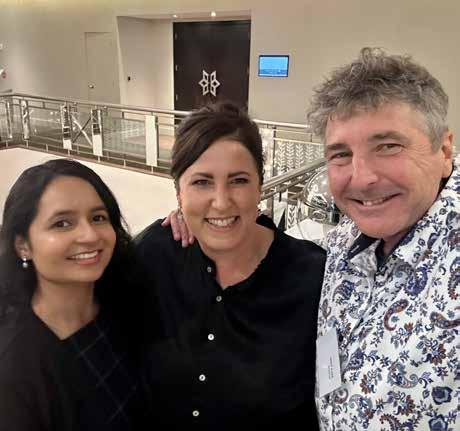
The absolute first attraction was getting to work with one of New Zealand’s most trusted organisations. I have grown up viewing the AA as a trusted brand that delivers for New Zealanders.
“The absolute first attraction was getting to work with one of New Zealand’s most trusted organisations. I have grown up viewing the AA as a trusted brand that delivers for New Zealanders.
“When the opportunity came up to be involved in transport advocacy and represent the transport interests of AA Members living in the Auckland region, I was extremely excited to come on board.”
Before being officially appointed as a Councillor in early 2023, Kritika spent five months attending meetings, understanding the governance structure and learning the ins-and-outs of transport advocacy. Recently, she was invited to National Council in Wellington to present on advocacy within the AA.
Kritika cites the support from her team as central to her success. “The support I have received from the AA has been extremely valuable. My Chair, Mark Yates, has always supported my growth. I have built different relationships across the organisation and I cannot wait to grow and learn more.”
It’s clear Kritika is a testament to the importance of youth involvement in community led advocacy – something she is deeply passionate about.
“Young people are not the leaders of tomorrow, we are the leaders of today. The present is what forms our future and being involved in our communities allows us to develop ways of thinking about the world we are growing up in.
“I have been able to build unique experiences and gain opportunities through the community and advocacy space and I would love to pave that way for other young people. It also helps to provide support, guidance and beneficial skills which flows on to other aspects of our lives.”
AN UPDATE on the achievements of the AA, along with a report on its financial performance and position at the end of the 2022-2023 financial year, is now available. For a copy of the latest Annual Report, go to aa.co.nz and search 'Annual Report' to download a PDF.
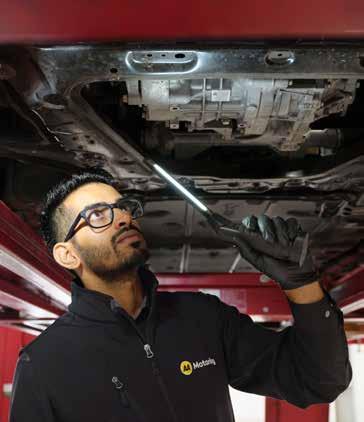
Servicing at AA Auto Centres now covers EVs.
REGULAR SERVICING can maximise your vehicle’s lifespan and value, and your electric vehicle (EV) is no exception.
AA Auto Centres nationwide now offer a comprehensive EV service, inspecting brakes, reduction drive fluid, tyres, suspension and more. The service doesn’t stop at just mechanical care, either. It includes extras to ensure your EV is a delight inside and out, with cabin deodorising, dashboard dusting and cabin vacuuming.
The teams at AA Auto Centres understand the unique needs of electric vehicles, with technicians equipped with the latest tools ready to service any make or model of EV. To stay on the road with confidence, knowing your EV will operate smoothly and safely, book regular services. The AA EV Service is available from $149 for AA Members and Non-Members from $169.
See aa.co.nz/cars and click ‘service your car’ to find your nearest AA Centre and book a service.


